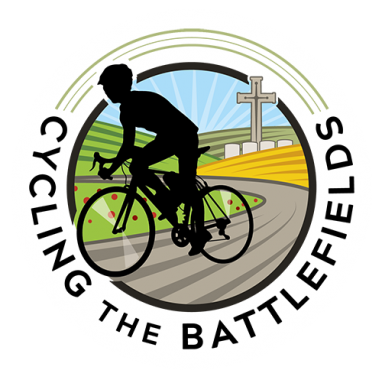

Cycling the Battlefields
Cycle the battlefields of the first world war with jeremy banning.

Have you always wanted to visit the iconic battlefields of the First World War?
Following the centenary period interest in the battlefields has never been greater. Rather than joining hundreds of others on well-trodden formulaic coach tours, why not try traversing the battlefields by bike?
Why cycling the battlefields is best
So much of the war’s fighting was to gain advantageous topography. Travelling by bike is by far the best way to appreciate the landscape; you feel every rise, every dip and change in gradient. Cycling the roads and tracks offers you a different, more intimate experience. You can take it at whatever pace you want and stop wherever you feel. What would be a simple drive in a car takes on more meaning when on two wheels…
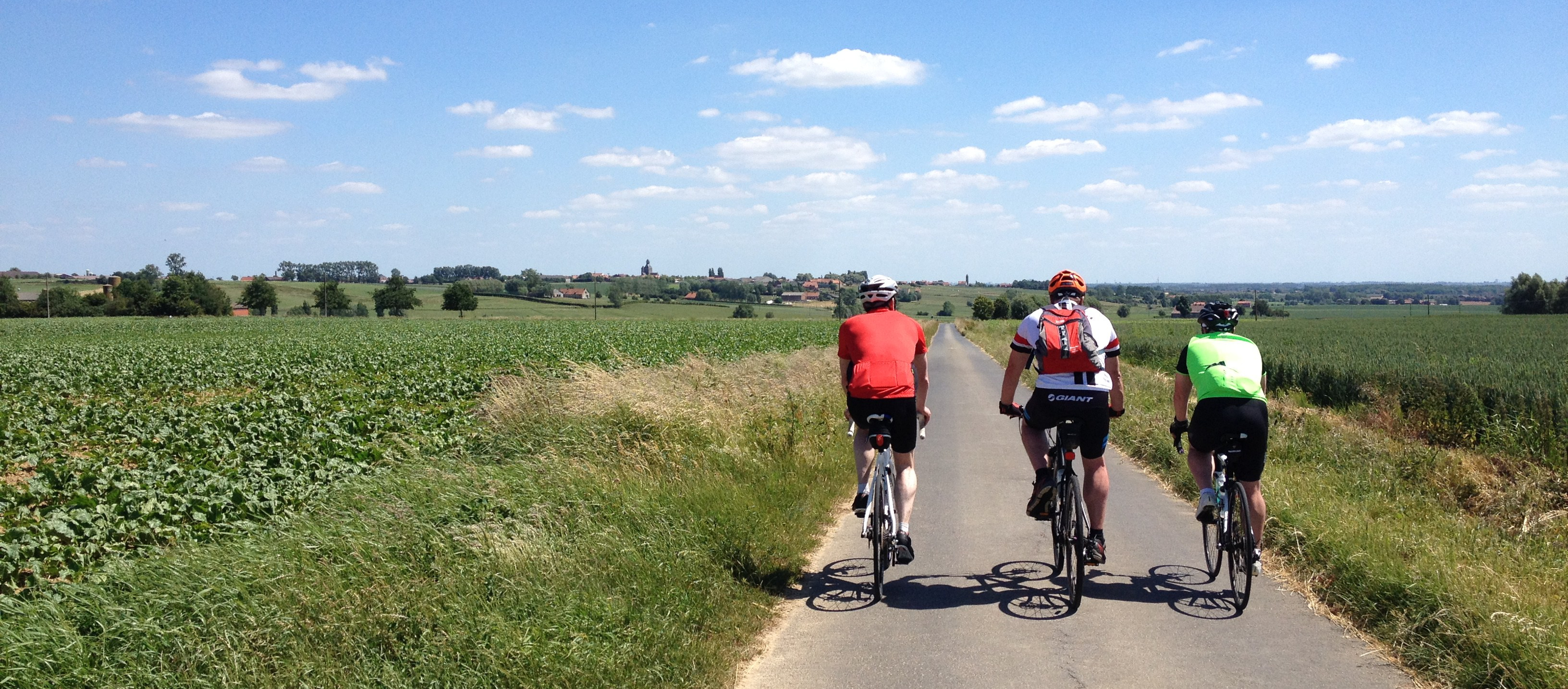
Cycling the quiet Flemish lanes of Messines Ridge south of Ypres
Why choose Cycling the Battlefields with Jeremy Banning?
Learn from an acknowledged and well-known expert. Jeremy combines a deep understanding of Western Front with the ability to cycle the terrain. He knows the best roads and tracks, the finest views and most poignant stories to bring the battlefield alive. Benefit from his twenty years experience of the battlefields and research for Who Do You Think You Are?, the BBC, Channel 4 and the Imperial War Museum. Jeremy has led numerous cycling tours over the past few years and has experience in groups of all sizes.
Recent testimonial: “We spent three fantastic days with Jeremy exploring the battlefields of the Somme, Arras and Loos – on bikes! As part of the trip Jeremy researched my grandfather’s story in the Irish Guards and found where and how he won his Military Cross (and got injured in the process). Jeremy is unbelievably knowledgeable about the battlefield sites specifically and about the First World War. He brings an incredible level of passion and insight to his subject. For both myself, and my son, who joined us, this was a poignant, indeed life changing experience. I can’t recommend Jeremy highly enough.” John O’Brien, Surrey
How it works
I do not advertise specific tour dates but, if you can get a group together, will guide you around whatever battlefield you want. Over the years I have guided groups (ranging from 2-14 people) and have found that by working this way, you get an interesting and challenging weekend away with friends without any worry about the route and simply share my guiding fee between you. By cycling in a group you save money and enjoy time with friends. What could be better?
I would recommend around 40 miles (65km) per day which provides plenty of scope for cycling quiet roads while providing the opportunity for you to visit the myriad cemeteries, memorials and museums. Routes with longer distances can be planned on request but please note longer rides obviously mean fewer stops on the battlefield.

Where to cycle?
I have created some example pages of major battlefield sites such as Ypres, Arras and the Somme (see Locations drop down tab on menu) but am happy to create a bespoke tour if you require.
Travel & Accommodation
I do not organise travel but if you can get your bikes out to France and Flanders then I can guide you, giving you an unforgettable experience. Recommended bike-friendly accommodation for all budgets available on request. Please note, many hotels have limited space for bikes so do ask before booking.
What type of bike should you use?
The routes ridden are mainly on good paved roads but, at times, we will venture on to some of the tracks that cross the battlefields. These can be harder going (but not impossible) for road bikes. I would strongly advise not using 23mm tyres as these are too prone to punctures. Most people I guide use road, hybrid, gravel or cyclocross bikes. Mountain bikes will make easy work of the tracks but will be slower on tarmac. As a guide, when cycling the battlefields I leave my lightest road bike at home, preferring to rely on an my steel winter road bike fitted with 32mm tyres. Using these, I have never had a puncture. If you have questions about the correct type of bike to use, then feel free to ask me for advice.
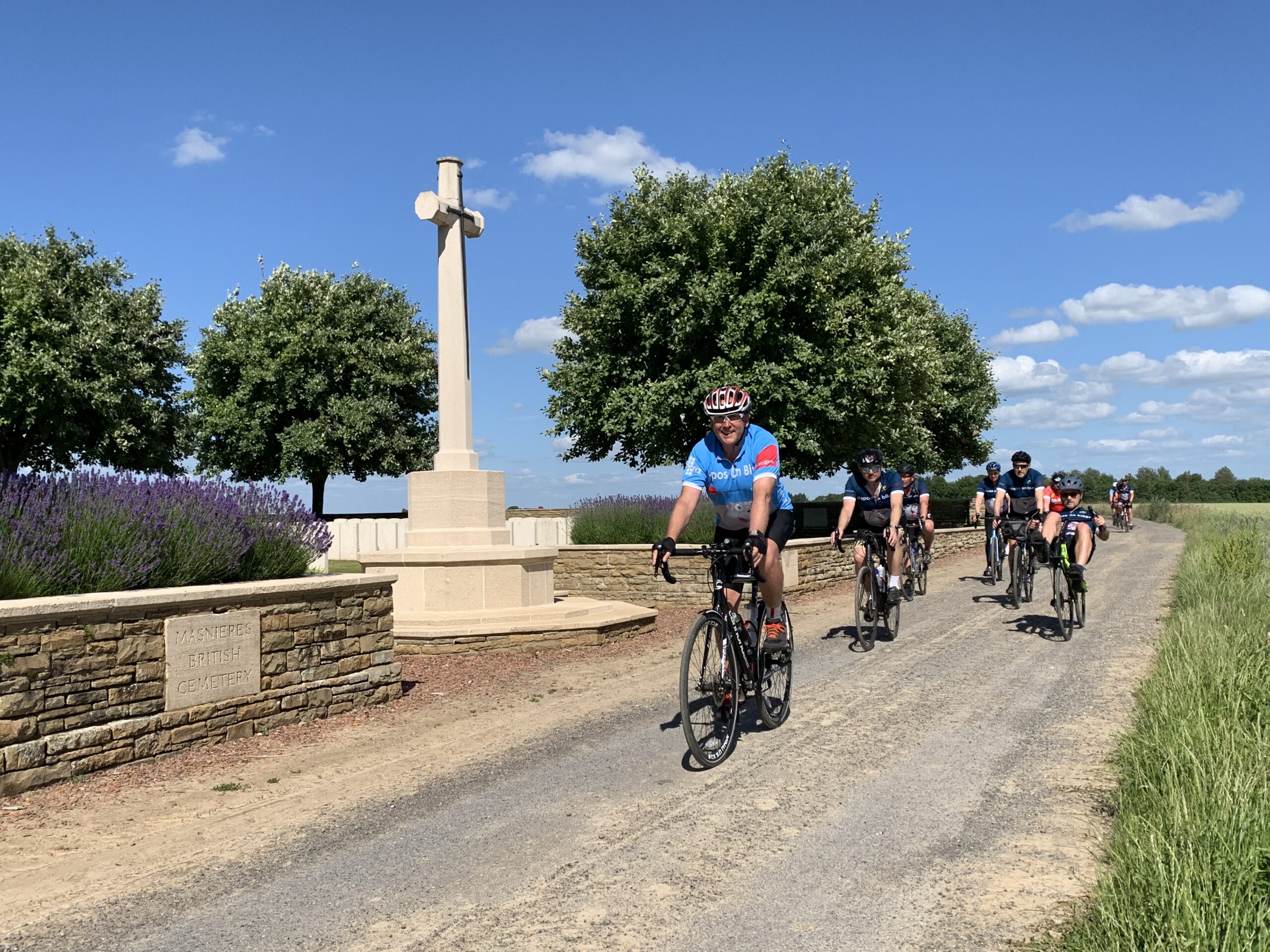
Cycling past Masnieres British Cemetery on the Cambrai battlefield
This is your trip so you will want to get as much from the day as possible. This requires a decent level of fitness. Rest assured, a full day on the battlefields can be taken at a leisurely pace so no need for any speed training but you should be able to cycle 40 miles (65km) without being in too much pain. There are not too many steep hills in the rolling terrain. The steepest hill I can think of is the 1km of road up to Thiepval from the River Ancre which, at its steepest, is an 8% gradient. If you can do that, you can easily do the rest! Example route profiles (using Ride with GPS) are available on each battlefield location page.
You will pay for my time spent guiding. Price is dependant on group size and is available on request. Bespoke trips (following individual soldiers or units) can be accommodated but special bespoke group rates will apply.
If you fancy joining me on the battlefields or have questions about cycling in the Somme, Arras or Ypres then please contact me .
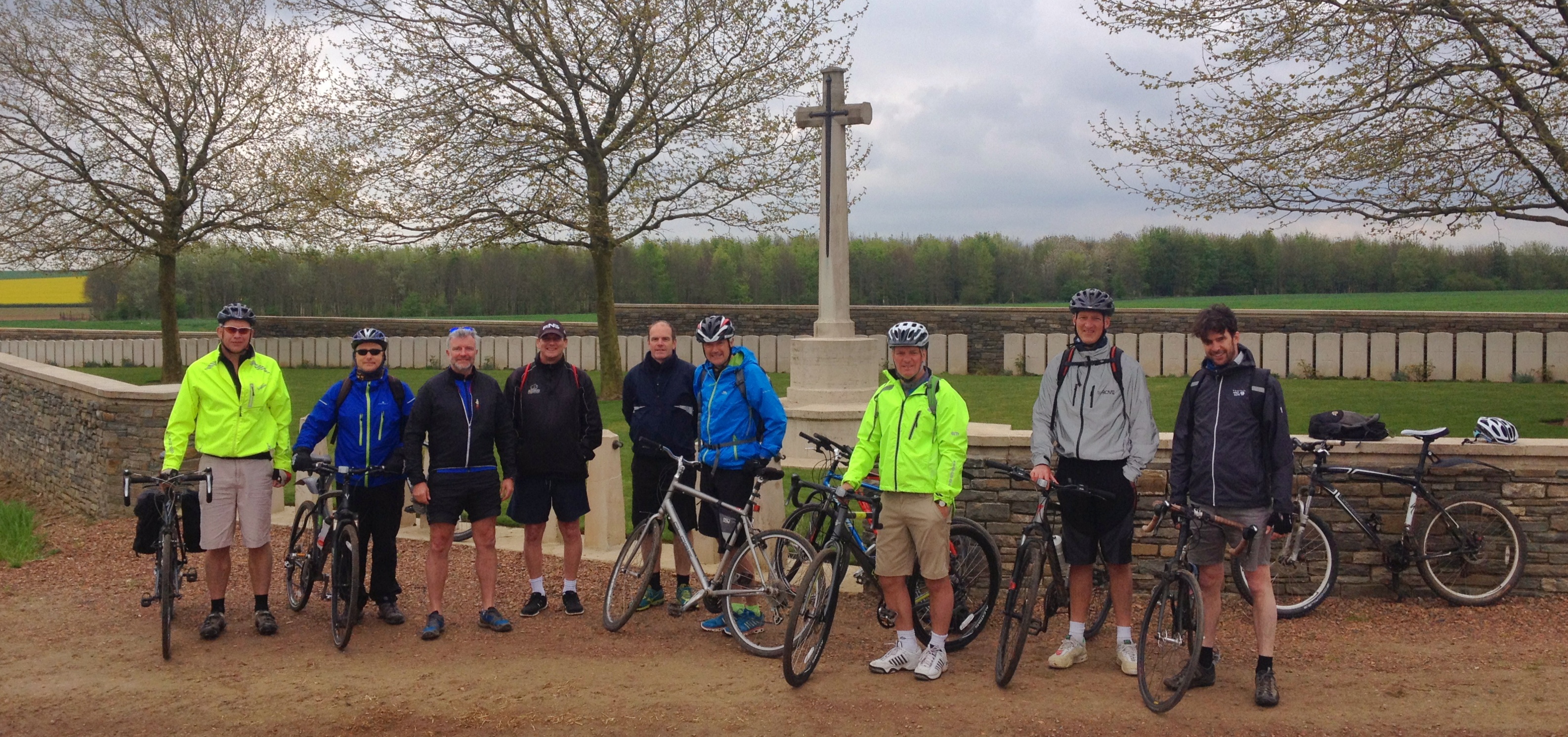
Cycling tour at Bootham Cemetery, Heninel – spring 2015
Share this:
- Click to share on Twitter (Opens in new window)
- Click to share on Facebook (Opens in new window)
- Click to share on Pinterest (Opens in new window)
- Click to share on LinkedIn (Opens in new window)
You are using an outdated browser. Please upgrade your browser to improve your experience.

Explore, Discover, Remember
Bespoke guided cycling and walking battlefield tours
Cycling Tour - View Prices and Schedule
Cycle The British Front Line Freewheel The Western Front
Discover the entirety of the British front line, from the flat plains of Flanders Fields in the north to the rolling countryside of Picardy in the south. Cycling along cycle paths and quiet lanes we travel at your pace to explore some of the most iconic sites in modern British history.
The Western Front tour offers a fully guided cycle tour of the key sites associated with the battlefields of the Western Front and includes time to explore the towns of Ypres, Albert, Amiens and Arras.
Tours generally take place over 7 days.
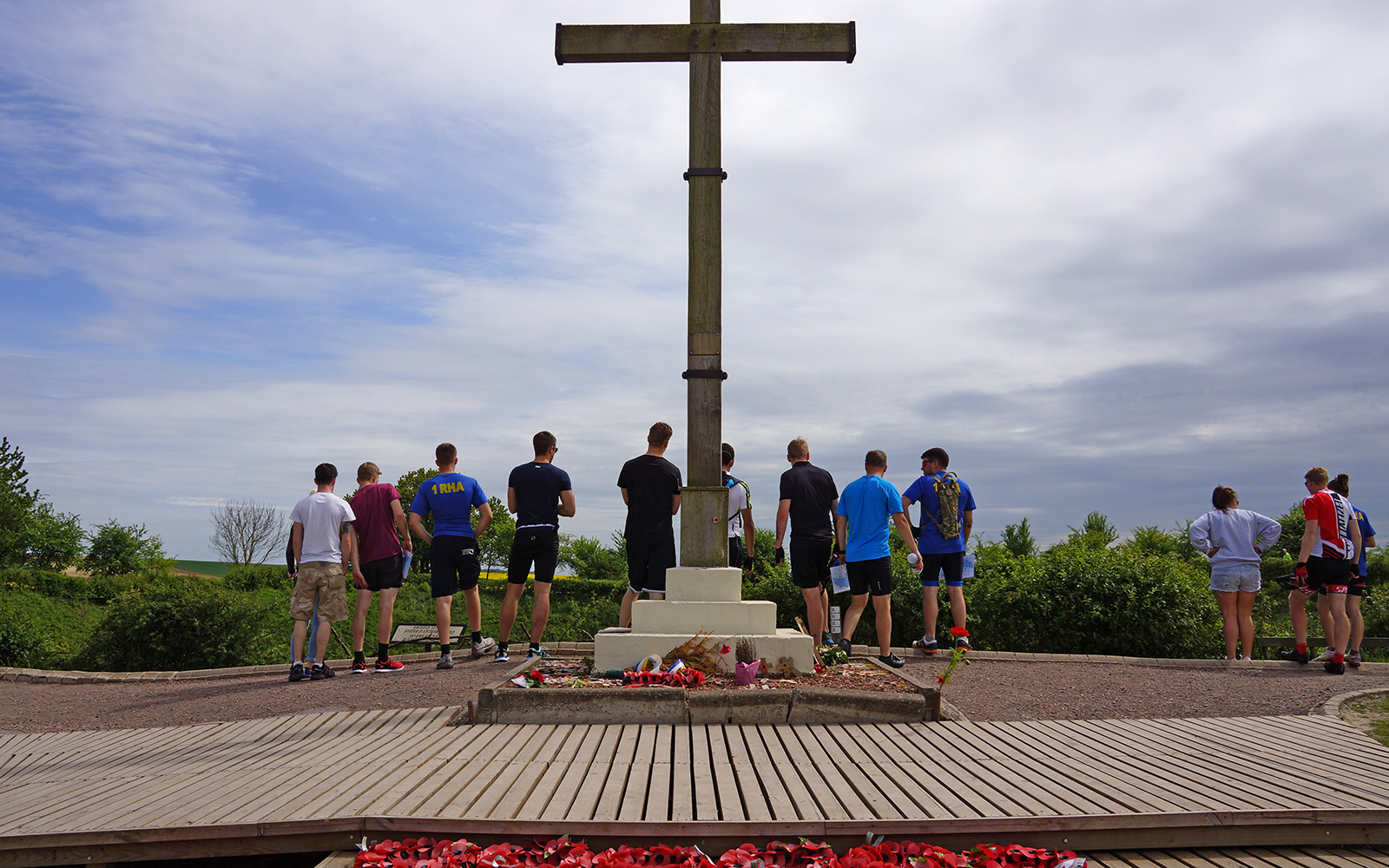
Bespoke Battlefield Tours
Because everyone is different we prefer the tailor-made approach to our battlefield tours . Whether travelling as individuals, members of a small or a large group, travel at your own pace to explore the sites included in our itineraries and those of your own choosing.
Remember, each holiday is bespoke. Anything is possible!
Get in touch with us today to discuss your bespoke tour requirements.
Excellent Value
Our cycling holidays generally include the following;
- Bed and breakfast accommodation in 3 and 4-star hotels.
- Luggage and equipment transfers.
- The services of a battlefield guide throughout your visit.
- Entry to museums
Schedule, Prices & Booking
Sample Tour Itinerary
Day 1 Meet at Eurostar Terminal, London, St Pancras International Station. Eurostar to Lille, local train to Ypres. Walking tour of Ypres to include a visit to the Menin Gate and attendance at the daily ceremony.
Day 2 Follow cycle paths and country lanes to the north and east of Ypres to take in Hill 60, Sanctuary Wood, Polygon Wood, Passchendaele and Langemarck. This route weaves between both the British and German front lines. We finish the day at Essex Farm, the Aid Station made famous by John McCrae.
Overnight in Ypres.
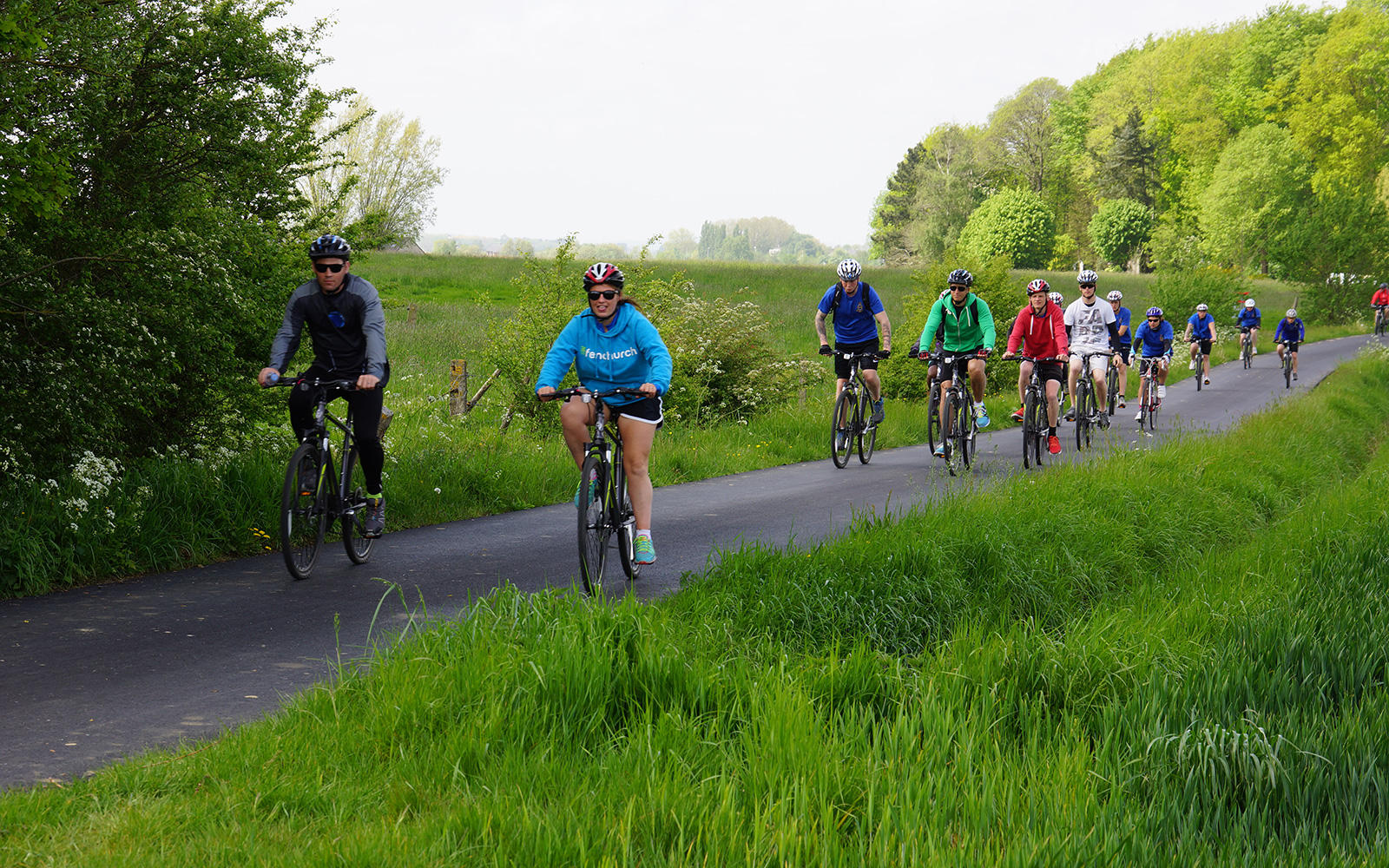
Day 3 Follow the front line to the south of Ypres towards the French border travelling through villages such as Wytschaete, Messines and Ploegsteert to witness the aftermath of some of the largest explosions of the war. From here we cycle up onto the Aubers Ridge to visit the ‘Forgotten Front’ visiting the most recent war cemetery at Pheasant Wood.
The day concludes with a visit to Loos as we near our overnight stay in Lens.
Day 4 Today we cycle from Lens to Arras in the hills of Artois. There a couple of ‘decent’ hills which give impressive views of the former battlefields. During the course of our cycle we will visit, Notre Dame de Lorette, Neuville St Vaast and Vimy Ridge.
We finish the day by cycling into Arras for our overnight stay.
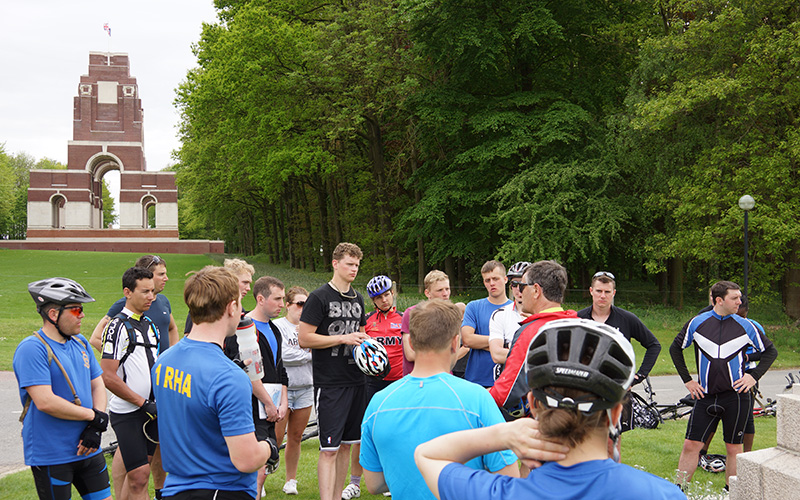
Day 5 Cycling today from Arras to Albert, we move into the Somme region. As we approach Albert the scale of the fighting here becomes apparent as we pass one cemetery after another. During the course of the cycle we will visit the memorials to the Pals battalions at Sheffield Park, the sunken lane at Beaumont Hamel, before cycling on to Newfoundland Park , the Ulster Tower and the Thiepval memorial to the missing.
Overnight in Albert.
Day 6 Albert to Amiens cycling. Our last day cycling, we by heading towards Delville Wood and High Wood before heading towards Amiens. For much of our journey we will cycle along the banks of the River Somme taking in Bray, Corbie and Villers Bretonneux.
Overnight in Amiens.
Day 7 Train from Amiens to Calais Frethun and then Eurostar to return back to London, St Pancras International Station.
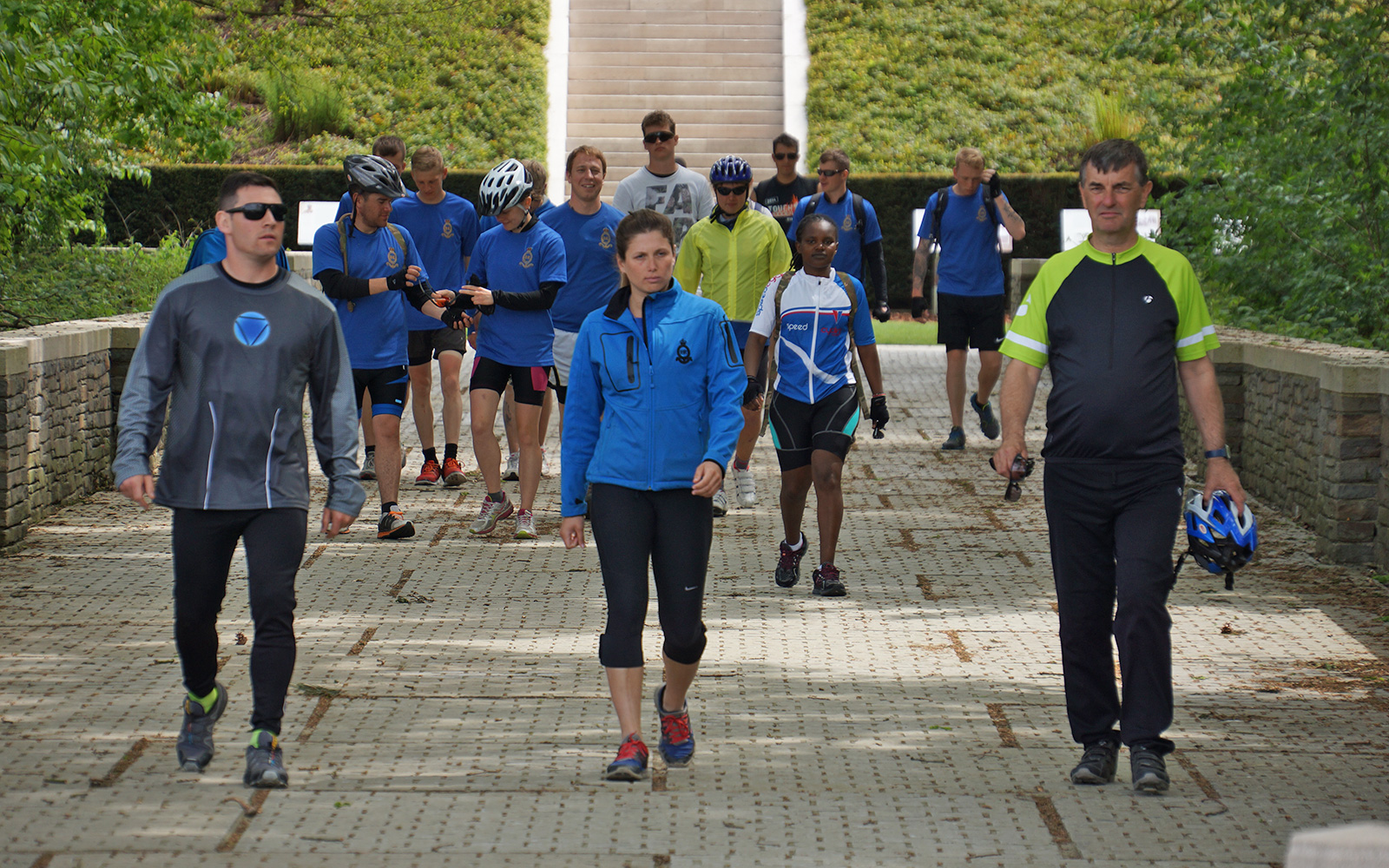
Accommodation
If you wish us to book accommodation, a wide range is available. The area has numerous 3 and 4-star hotels. Many clients opt to book on a bed and breakfast basis. There are plenty of restaurants en route, catering for most tastes. We will be on hand to advise you of the best places to eat in any case.
Travel Arrangements
If you would like us to make travel arrangements for you our tours to the Western Front typically start and finish St Pancras.
Outward Journey: Travel by Eurostar to Lille. Transfer to a local service from Lille to Ypres.
Return Journey: Return journey from Amiens to Lille Flandres and on to St Pancras where our tour finishes.
Please note that for all cycling tours you are required to bring your own equipment including, for this tour, your own bicycle.”

Everything you need to know about cycling in France your independent guide
Cycling the Somme, France
Cycling is one of the most peaceful ways of visiting war memorials – andrew webster, author of shot & grape tour: bordeaux to burley-in-wharfedale , cycled the battlefields of the somme..
The Memorial to the Missing of the Somme, Thiepval. The memorial, the largest British monument of this type in the world, was designed by Sir Edwin Lutyens and commemorates the names of 73,000 British and allied soldiers who died on the Somme and have no known grave. Photo: Amanda Slater
Use our bespoke service to find an expert-led tour of the battlefields
See also our article on cycling the D-Day Beaches of Normandy.
A great introduction to battlefield touring in France by bike is the Battle of the Somme. Fought in 1916 during the First World War, it covers an area of about 200 square miles with the front line being about 30 miles long. Lord Haig, the Commander in Chief of the British and Commonwealth Army, launched his attack on the first of July with 100,000 troops. By the end of that day, 60,000 were casualties of which 20,000 died. It was the worst day in the history of the British Army. Hardly any ground was captured from the Germans and entire communities were decimated due to the practice of keeping men from the same town together in each unit, the so called “Pals” battalions.
An ideal starting point for a cycle tour of the Somme – which falls largely in the Picardy region – is the medieval town of Arras. On the northern edge of the battlefield, it is 65 miles from the ferry port in Calais, and 74 miles from the port in Zeebrugge, Belgium. There are battlefields at Agincourt and Waterloo from earlier periods to consider on your way to the Somme. For those cyclists not wanting to carry their luggage with them, I suggest using Albert as a base – it's a bustling town in the centre of the battlefield area.
Leave Arras south west on the D3 to Gommecourt where you start to pass the first of over 200 cemeteries that cover this battlefield.
Continue onto Hebuterne and on the D28 and D174 to Auchonvillers for tea at Avril Williams famous tea rooms. After your refreshments, you can find nearby the location of the famous crater of Hawthorne Ridge , caused by a huge mine detonated at 2.20am on the morning of the battle. Just down the hill from the crater is the famous lane occupied on the day of the battle by the Lancashire fusiliers who were captured on that famous and haunting black and white footage just before going over the top.
Follow the D163 to Beaumont-Hamel and onto Newfoundland Park , a large area of preserved battlefield south-west of Beaumont-Hamel. A bronze caribou, bellowing out across the battlefield, commemorates the Newfoundlanders heroism here that day. A short walk out across no-mans land, past the “Tree of Death” marks the limit of their advance there that day. Do visit the excellent museum and talk to the young Canadians who run the memorial site and museum.
Begin by crossing the River Ancre to visit the Ulster Tower which commemorates the actions of the 36th (Ulster) Division during the battle. There is a good little museum just behind it. Continue up the hill to Thiepval the site of Sir Edwin Lutyen’s Memorial to the Missing which bears the names of 73,412 British and South African officers and men missing on the Somme in 1916/17. Here you will also find the largest museum commemorating not only the Somme but the whole of the First World War. There are computer facilities to search the database for relatives who fought in the war.
Follow the D151 south to Aveluy and onto Albert for your overnight stay.
After breakfast and a visit to the museum at the side of the Basilica Notre Dame, head north out of Albert on the D129 to La Bouselle. Snake through the village and follow the signs for La Grande Mine. Lochnagar is the largest surviving crater from the war. It was created by 60,000lbs of ammonal exploded beneath the German front line allowing the Tyneside Scottish to take the position.
Continue on to Fricourt and the German cemetery and then onto Mametz where south of the D938 you can visit the Devonshires cemetery, interred en masse in the old front line trench.
Head back north now to Longueval via Montauban de Picardie. Delville Wood lies east of Longueval. Amongst the troops that fought for 'Devil’s Wood' are the Scottish, South Africans and New Zealanders.
Then head back west to Pozieres on the D20. Here you find the Australian Memorial and the idiosyncratic Burma Star Cafe full of artefacts and trench recreations.
Take the D929 north east to Bapaume and your final night’s stay before returning to Arras. As you cycle north-east, glance to your left and you may well see the Thiepval Memorial. On a bad day the weather reminds you that on that sunny day in July 1916 there was utter desolation to the west. By the time the battle finished soldiers were dying of exhaustion and exposure. Let us remember them.
The Canadian Memorial at Vimy Ridge includes preserved trenches and mine craters. Photo: Amanda Slater
After breakfast and a stroll around Bapaume, follow the D1 and D919 north to Arras with clusters of cemeteries along both sides of the road. Arras is an interesting medieval town, the ancient capital of Picardy. Visit the Grand Place to view the wonderful buildings restored to pre-WW1 conditions. If you have time head north out of Arras to visit the Vimy Memorial honouring the Canadian action there in 1917. It was an action often said to mark the beginning of Canadian nationhood.
Andrew Webster completed a 1100-mile journey through France in 2006. He has since cycled hundreds of miles in the south-west of the country. He is the author of Shot & Grape Tour: Bordeaux to Burley-in-Wharfedale , which includes his cycle tour of the Somme.
Accommodation for bicycling the Somme
Zoom in on our map below and click the icons for cycling accommodation that has secure bike parking. You can also search our Where to stay section .
Maps for cycling the Somme battlefields
Both Michelin and IGN (Institute Geographique National) provide an excellent range of maps for cycle touring in France. See also IGN's Amiens/Arras ( UK , US ), Arras-Vimy Ridge ( UK , US ) and the Archeux-en-Amienois topographical map , which includes the main section of the Somme battlefields. There are also IGN maps to Bray-sur-Somme ( UK , US ) and Albert ( UK , US ), among others.
For those preferring the electronic solution, Memory Map now provides the iGN maps of France on DVD for transfer to computers, smartphones and handheld GPS units. See also Garmin's Edge series .
Lastly for those wanting to venture across France visiting other battlefield check out IGN 908 France Lieux de Batailles which shows over 100 battles over the last 200 years together with background information and sites of memorials.
Guidebooks for cycling the Somme
Shot & Grape Tour follows my own trip from Bordeaux to England, via the Somme. There is also Walking the Somme ( UK , US ) by Paul Reed, but don't be put off by the title as it's been written with both walkers and cyclists in mind. It features 16 separate day routes around the Somme, taking in all the major memorials and covering off an amazing amount of war history related to each itinerary. Paul Reed is also the author of several other titles in the same series, including Walking Arras ( UK , US ). Both Reed books are published by Pen & Sword, a company that specialises in books on military history.
See also Lonely Planet’s Cycling France , and Major and Mrs Holt's Battlefield Guide to the Somme ( UK , US ) for suggested routes and itineraries ( there's also a map ). See also The Complete War Walks: From Hastings to Normandy by Richard Holmes ( UK , US ), which can be adapted for cycling.
Useful websites
Terence Munson’s webpage also has a useful itinerary and helpful notes for rail, ferries and B&Bs. Somme Battlefields is the official website for war tourism in the area, and has some useful links and accommodation options.
Related articles
- Maps for cycling in France
- 2019 Tour de France Official Race Guide
- Tour de France 2019 route: Stage-by-stage guide
2024 Tour de France program and race guide
- Tour de France 2024 route: Stage-by-stage guide
- 2023 Tour de France program and race guide
- Tour de France 2023 route: Stage-by-stage guide
- Taking bikes on trains to Calais and the Somme - map and advice
On the blog
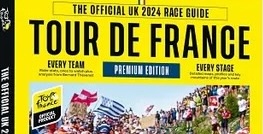
AVAILABLE TO ORDER NOW! The official Tour de France 2024 race program and guide includes all the route maps for each stage, plus stage start and end times, and team and rider profiles.
Posted: 23 Apr 2024
Cycling in France?
Search for tours & accommodation
What are you looking for? What are you looking for? All Accommodation - Campsites - Hotels, hostels and B&Bs - Self-catering All Tours - Guided - Self-guided
Where do you want to look? Where do you want to look? All France /r/n Alsace /r/n Aquitaine /r/n Auvergne /r/n Brittany /r/n Burgundy /r/n Champagne-Ardenne /r/n Corsica /r/n Franche-Comté /r/n Languedoc-Roussillon /r/n Limousin /r/n Loire Valley-Centre /r/n Lorraine /r/n Midi-Pyrénées /r/n Nord-Pas-de-Calais /r/n Normandy /r/n Paris-Île-de-France /r/n Pays de la Loire /r/n Picardy /r/n Poitou-Charentes /r/n Provence-Alpes-Côte d'Azur /r/n Rhône-Alpes /r/n
Share this:
© 2011-2024 Freewheeling France | Copyright, Cookies, Privacy and Advertiser T&Cs |
A soldier's cycle: visiting World War I battlefields by bike
Matt Lamy visited the Somme and re-imagined the story of a cyclist turned soldier. Photos by Andy Jones
- Sign up to our newsletter Newsletter
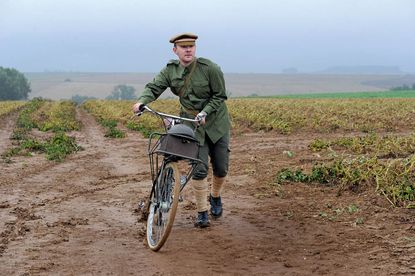
Life, here, held very few pleasures for Arthur Baynes.
His clay pipe — the smell and taste of which still offered the faintest reminders of home — was quickly becoming as one with the wretched clay soil of this Somme Valley.
The light-headed exuberance that used to accompany alcohol had been contaminated by the experience of swigging rum in the terrifying moments before heading over the trench parapet.
Even chasing women, when it happened, had become a joyless affair. There was no fizzing expectancy of passion. In the days away from the front, if the lads were lucky, they might find a cold, loveless experience with a local farmer’s wife or daughter. But those were clinical transactions, in emotion if not cleanliness.
>>> Icons of cycling: The National Cycle Museum
At thoughts like this the distant voice of Reverend Cole at St Mary’s on Bramall Lane, back home in Sheffield, would whisper admonitions of vice in Arthur’s head. But then, as Arthur had found out, Reverend Cole wasn’t always as sure about things as he thought. For example, he’d always said that hell lay at the bottom of a great fall. But, as Arthur knew, in this part of Northern France, hell could be found little more than eight feet down.
After what Arthur had seen in the last few weeks, perhaps simply living, breathing, was enough. Perhaps hoping for even a momentary burst of happiness, a fleeting experience of stimulated senses, was too much to contemplate. Perhaps just being able to think about past comforts was a privilege. And in moments of reflection Arthur did think about many things: his mother and father; his little sister; but most of all he thought about his Raleigh number 29 road racing bicycle.
Get The Leadout Newsletter
The latest race content, interviews, features, reviews and expert buying guides, direct to your inbox!
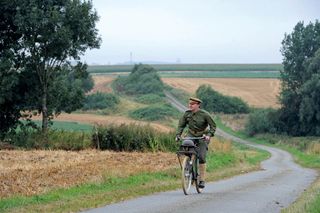
King and country
Arthur was 23 years old, a teacher by profession, a cyclist by choice. Back at home he had been a member of the Sharrow Cycle Club. He’d been pretty quick, too, winning plenty of the club’s cups and medals. But competition was only part of his life awheel. What he enjoyed most was heading out on long rides over the Peaks, or going on weekend camping trips with his clubmates, taking in the glorious Yorkshire air. ‘God’s own country’, so it was called. Another entity could claim rights to the Somme.
Arthur and a few of the other lads in the ‘Sharrow’ had seen Lord Kitchener’s posters go up around town, asking for volunteers to fight the Hun. It sounded like an adventure, a continuation of club companionship, and they were all eager to do their duty for King and country. So they trotted down to the Town Hall and signed their life over to His Majesty, joining other groups of men from places like the university, banks and local businesses. Together they became soldiers of the Sheffield City Battalion — the ‘Sheffield Pals’.
After months spent learning the basics of soldiering at Redmires — a camp west of Sheffield that could almost match Arthur’s present environment for bleakness — and then further training around the country, they were sent off to Egypt to protect the Suez Canal. Soon they were moved on. By the start of April 1916 they were in the trenches of the Western Front, opposite the heavily-fortified town of Serre.
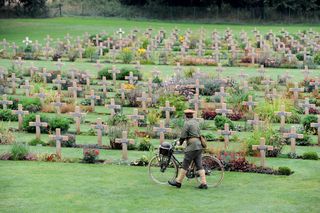
Death and dirt
Compared to their demanding but largely uneventful time in Egypt, life here was unsettling from the start. Private Alex McKenzie had been the first Sheffield lad killed, by a German rifle grenade, on the battalion’s very first morning at the front. Then, on the night of May 15, 60 of the Pals were killed or wounded when the Germans launched a trench raid and bombardment. Arthur had seen friends literally blown apart by the shells. Others he had helped to carry away, limbs missing, flesh torn, lives destroyed.
If it wasn’t a raid or counter-raid, or hidden snipers waiting for pot-shots over the trench brow, or the almost unbearable thunder of artillery shells, there was the inescapable, cloying mud. There were the rats that scurried by their feet or over their bodies as they tried to sleep. The lice that inhabited every seam and crevice. The constant dampness that permeated their uniform. The constant fatigue that permeated their bodies. The constant fear that permeated their souls.
>>> Icons of cycling: La Trouée d'Arenberg, Paris-Roubaix's toughest cobbles
Now, though, it was early June and the battalion had moved a few miles back from the front to a camp at Bus-les-Artois. There was some slight respite. The men knew a major push was being planned and the Sheffield Pals were training for it. But the immediate terror and filth of the trenches were for somebody else, for now. So, on a quiet day, when Arthur saw the Royal Engineer’s bicycle lying unused, he had to ask. Just a quick ride, that was all he wanted. And in a moment of generosity it was granted.
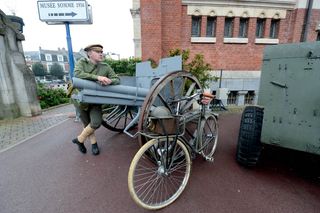
Relived pleasures
It might have been a foreign bicycle, in a foreign land, and Arthur himself was a different person to the naive young man who had left Sheffield a year ago, but the joy of pedalling surged through him just the same. His sensibilities, which had been blunted by shock and hardship, re-awoke instantly as he headed towards Courcelles-au-Bois and then Colincamps on the damply glistening prepared road. Of course the bike was a bit heavier and less sprightly than his Raleigh, but it rolled, and it pedalled, and right now that was all he needed.
How far could he ride? He didn’t care, spinning along with the gentle waves of shallow hillocks, twisting and turning through their troughs. So different this flowing, albeit now charred and pockmarked landscape, to the challenging slopes of his native Peak district. Occasionally Arthur was forced onto a field track, letting the machinery of war pass by. Even more occasionally he would try to cross a field, causing the thick Somme gloop to stick to the bicycle’s tyres, frame, mudguards, anywhere it could reach.
He headed down to Auchonvilliers — or ‘Ocean Villas’, as the men of the British Expeditionary Force had taken to calling it — and glanced eastwards, towards the front line. As Arthur looked out across the small valleys, a blanket of mist lay over the brown land: nature’s way of hiding man’s inhumanity. But Arthur knew what lay beneath the covering. The incessant pitter-patter of falling drizzle might as well have been the soft sound of young bodies hitting the sodden earth. In the areas of landscape that could be viewed, craters had obscured the squared pattern of fields, like cigarette holes burned into an unloved patchwork blanket.
At Ocean Villas vast ranks of troops from other battalions congregated. In another time it would have been a perfect place for a tea stop, a Gallic version of Hathersage on his local rides at home. But in these circumstances Arthur didn’t want to stop. He just wanted to
His thoughts turned back to Sheffield, where the ‘Sharrow’ was also pedalling on despite its depleted numbers. The older club members who remained sent out warm clothes and food, not to mention the club newsletter to the lads at the front.
While the practical provisions helped to raise spirits, Arthur’s eyes lit up most when he turned to the results page and saw his club records still standing. “You can take the cyclist out of the competition, but you can’t take the competition out of the cyclist,” his mates would laugh every time they saw Arthur’s smug smile. But with so many of the youngest and fittest club riders now sharing the French mud alongside him, his records were safe. Safe for a generation, in fact.

Distant normality
Up and onto a fertile plain he cycled, leaving behind some of the sights and smells of war. Agricultural elements took their place. The aroma of cows, normally something to turn the nose, wafted over him fresh and wholesome compared to the fetid stench of the trenches. Although the flat fields to either side were bruised and scarred, young shoots of maize grew strong and upright, resisting the wind and rain. They’d be cut down before summer was out.
The open road, the open countryside, and the effects of cycling proved intoxicating. In these circumstances the heavy, dank haze, which so affected morale otherwise, seemed invigorating. How unlike the enclosed sensation of wearing a gas mask, he thought.
>>> Icons of cycling: Herne Hill Velodrome
Arthur descended and passed through the village of Mesnil-Martinsart, with its battle-weary church and village hall, and stone barns with arched gateways. Somewhere nearby the crowing of cockerels took the place of artillery explosions. On a valley floor he rode between two thin rows of trees with an alternating arrangement of green and terracotta-coloured fields lying just beyond them.
He thought about his own cycling at home, when he’d been racing, when he’d had to sacrifice dignity and composure to win or ride quicker. Here, at war, dignity and composure was a daily personal battle, yet those experiences on a bicycle were of little value. At home he could have stopped at any time, or soft-pedalled until he recovered. There was no soft option available at the front. At home his bicycle was freedom. There was no true freedom here.
The terrain grew slightly tougher. Copses appeared on the surrounding slopes, and bigger climbs tested his stamina. Having seen fatigue as a precursor to death in the trenches, it was odd to rediscover that fatigue on a bicycle felt strangely life-affirming. On a bicycle he felt more than just another body trying to delay being consumed by the Somme’s rich soil — he felt able to challenge it, control it, master it.

Moment of calm
The road, such as it was, snaked its way to the outskirts of Aveluy and he was soon cycling along a boulevard of saplings, alongside the Ancre river, towards the town of Albert. After the relatively insignificant pockets of civilisation he had passed through so far, Albert was altogether different. The buildings were continuous, not interspersed, and made of strong brick. Shutters guarded the windows. A few houses even retained their Juliet balconies. But not even a town with these qualities could avoid the ravages of war. Half the strong bricks had been turned to rubble. Most of the shutters stood drunk on duty. And romance had long since made way for survival.
As he rode towards the town centre he looked up at the statue of Virgin and Baby, which had once gazed commandingly over Albert from their plinth atop the Basilica. Having been hit by an artillery shell they now hung precariously, lower than horizontal. Behind them light
and dark clouds were merging ominously. The atmosphere felt expectant. A storm was brewing.
Arthur smiled to himself, aware his brief ride from reality would soon be over. He knew he would have to return to Bus Wood, and the bicycle would have to be returned to its owner. But for now he wanted to pretend this was a typical Sunday ride, a spin like any other through a benign countryside. He realised that for a couple of precious hours he had forgotten about war. It was just him, the bicycle, and the road.

Epilogue — Two years in the making, 10 minutes in the destroying
Despite being fictional, our story is based on real places, events and people, including Arthur Baynes.
At 7.30am on July 1 1916 — the beginning of the Battle of the Somme — Arthur’s friends in the Sheffield City Battalion rose up from positions in No Man’s Land and began to walk towards German lines on the outskirts of the village of Serre.
Although British artillery had supposedly weakened the enemy, the response was ferocious. The first and second waves of Sheffield Pals were brought down in a hail of machine gun fire; the third and fourth waves were cut in half before they even reached No Man’s Land. Of the 783 Sheffield City men who went over the top, 248 were killed, 265 seriously wounded, and 75 slightly injured but still on duty.
The Sheffield City Battalion continued on until disbandment in early 1918, but in little more then 10 minutes its ‘Pals’ spirit had been lost forever.
Between 1914 and 1918, almost 10 million soldiers, sailors and airmen lost their lives in the Great War.
We will remember them.
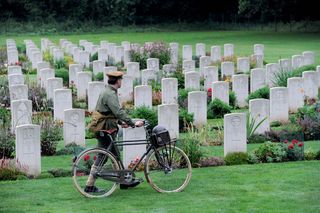
Bicycles at War
The British Army had volunteer cyclist units among its numbers since the 1880s, and when war broke out in 1914 there were 15 Territorial cyclist battalions. These were used for coastal defence work in the UK until 1915 when the Army Cyclist Corps was founded.
The first cyclist units to go overseas went to France, Flanders and Gallipoli. In the early days of the war, military cyclists were employed as scouts, although in Belgium, British and German cycling units actually engaged each other in combat. However, when the war became bogged down in trench warfare, the effectiveness of cycle-mounted soldiers was hugely compromised and some members of the Army Cycle Corps were converted back into infantry units.
Meanwhile, individual divisions often had their own cycle companies, which were used to reinforce divisional cavalry squadrons, serve as military police and provide working parties to assist divisional engineers. Other cycling troops tended to take on three main roles: messenger work, scouting and security patrols, especially along canal systems which were vulnerable to sabotage.
Because of the difficulty using bicycles in combat the British Army decided there was no long-term role for cyclists and the Army Cyclist Corps was disbanded in 1919.
The National Cyclists’ Memorial, commemorating those riders who gave their lives in World War One can be found at Meriden, West Midlands.
Roadside history
One of the most astounding and appalling things for any visitor to the Somme battlefields is the frequency with which you encounter roadside military cemeteries.
The scale of death here is almost incomprehensible, and body parts are still being recovered to this day. However, the Commonwealth War Graves Commission does a magnificent job keeping these countless memorials in perfect condition.
Also being recovered to this day are munitions, as farmers plough land that had once been a warzone. We found these shells at the side of the road near the Sheffield Memorial Park, and British visitors we spoke to at Thiepval had found bullets and grenades there in recent years. If you visit, remember: it might be 100 years old but this was live ordnance and it is very dangerous. Please don’t pick anything up.

Cycle touring: battlefields and beyond
As well as being historically fascinating and emotionally stirring, this area of northern France heading into Belgium is excellent cycling territory. For Arthur’s ride we have focused on only a small section of the area surrounding where the fiercest fighting of the Battle of the Somme took place, but there are many ways to enjoy a much longer cycle tour.
The Somme Valley cycle route
If you head south along the coast from Calais you could cycle down the Somme Valley, right from where it meets the Channel at Saint-Valery-sur-Somme. There are some great on and off-road cycle routes nearby, and the canal path from St Valery to Abbeville is beautifully flat. From Abbeville keep following the Somme towards Amiens and all the way to Péronne.
Historial de la Grande Guerre, Péronne
At Péronne you’ll find the Historial de la Grande Guerre museum: a leading centre for World War One study with more than 80,000 visitors a year. Presentations are made in three languages — French, English and German — while the museum’s displays and films show what life was like for soldiers both in the trenches and behind the front line.
Museum to South African Forces, Delville Wood, Longueval
The museum at Delville Wood — 10 miles north-west of Péronne — is one of the most impressive memorials in the area, and is dedicated to the memory of 25,000 South Africans who died in the two World Wars and Korea. The museum is built around a centrepiece of the Cross of Consecration and was designed to be a replica of a star-shaped stone fort in Cape Town, called the Castle of Good Hope.
Canadian National Vimy Memorial
Continuing north from Longueval, beyond the town of Arras — which, incidentally, is a perfect base for anybody wishing to explore the Somme — you’ll find the Canadian Memorial at Vimy Ridge. It’s possibly even more striking than the incredible monument at Thiepval, standing as two gigantic menhirs upon the hilltop. The 250-acre preserved battlefield park in which it’s found is a tribute to the 60,661 Canadian Expeditionary Force members who died in World War One.
Paris-Roubaix
Away from war, head east from Vimy, past Lens and Carvin, to Mons-en-Pévèle where you could pick up the route of the Paris-Roubaix Classic cycle race. From Mons it’s possible to follow the event’s final 30 miles, including its last 10 sectors of historic cobbles. While bike racing is a world away from the horrors of war, the cobbled course will take you back in time to experience what road conditions were like 100 years ago.
Menin Gate, Ypres
Finally, 20 miles north-east from Roubaix, over the border into Belgium, lies another site of ferocious fighting during World War One: Ypres. In the town centre stands the impressive Menin Gate, commemorating soldiers of the British Commonwealth who fell in the area and who have no known grave. As with the Somme, the area around Ypres has no shortage of other things to see.
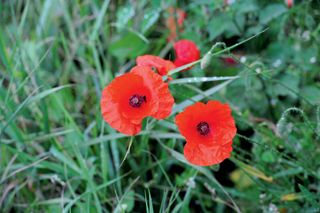
This article originally appeared in Cycling Active magazine February 2014 issue
Thank you for reading 20 articles this month* Join now for unlimited access
Enjoy your first month for just £1 / $1 / €1
*Read 5 free articles per month without a subscription
Join now for unlimited access
Try first month for just £1 / $1 / €1
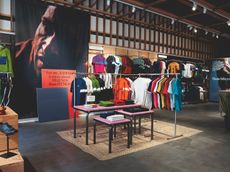
Citing 'strategic realignment and current market dynamics' Rapha North America is reportedly closing its current Bentonville, Arkansas, and has laid off six out of the office's eight employees.
By Anne-Marije Rook Published 26 April 24
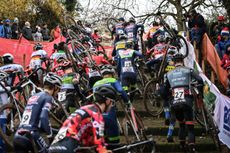
Trek becomes American UCI Cyclocross series title sponsor, adding a fourth race to the series in October at its headquarters in Waterloo, Wisconsin.
By Kristin Jenny Published 25 April 24
Useful links
- Tour de France
- Giro d'Italia
- Vuelta a España
Buyer's Guides
- Best road bikes
- Best gravel bikes
- Best smart turbo trainers
- Best cycling computers
- Editor's Choice
- Bike Reviews
- Component Reviews
- Clothing Reviews
- Contact Future's experts
- Terms and conditions
- Privacy policy
- Cookies policy
- Advertise with us
Cycling Weekly is part of Future plc, an international media group and leading digital publisher. Visit our corporate site . © Future Publishing Limited Quay House, The Ambury, Bath BA1 1UA. All rights reserved. England and Wales company registration number 2008885.

WW1 Battlefields ▲▼ Sort by name Sort by newest Sort by oldest Sort by longest Sort by shortest
Log in with your cycle.travel account:
Log in Cancel
Or simply use your account on:
Twitter --> Facebook Apple Google
Sign up · Forgotten password?

- Itineraries
- Tour Itineraries
- Their Stories
- The Diggers
- Photo Gallery
- Fallen Soldiers
Half a million Australians and New Zealanders travelled half-way around the world to fight in the
First World War.
Join me to learn their story by cycling and walking the Western Front in France and Belgium.
I’m often asked how and why I came up with the idea for Battlefield Cycling. It came to me over time but I can remember standing in the middle of a once-devastated battlefield, where thousands of brave men had fought and lost their lives during World War I. The wind gently blew through the now serene landscape, whispering stories of courage, sacrifice, and tragedy.
As I stood there, trying to imagine the horror that unfolded in this very spot over a century ago, my heart filled with an overwhelming sense of sadness and despair. How could such a beautiful place be forever scarred by the atrocities of war?
But at the same time, something else stirred within me – a spark ignited by my passion for cycling and military history. What if there was a way to bring these two worlds together? To honour those who fought so bravely while also sharing my love for cycling with others?
And just like that, an idea began to take shape – one that would change not only my life but also the lives of many others.
Why join our battlefield tour?
People from all walks of life have joined our guided tours through famous WW1 battlefields in France and Belgium – each one coming away with newfound historical and cultural experiences about our shared past and personal memories they will cherish forever.
Perhaps the thing that amazes me most is how Battlefield Cycling has helped others overcome personal struggles: graves being visited by family members, possibly for the first time ever; grandchildren standing on the ground where grandad experienced the physical or mental trauma that was to define the rest of his life; friends and families connecting on long bike rides through picturesque landscapes to the locations associated with their ancestors; even individuals battling depression discovering hope amidst fields once torn apart by war.
Battlefield Cycling is more than just another tour company; it's proof that passions can be combined to create something truly special and life-changing.
Frequently Asked Questions
Please reach us at [email protected] if you cannot find an answer to your question.
Yes, that is possible. While the main group rides from site to site, there is a support van that comes out most days that a non-rider can use. There are some sites that the van doesn’t get to, due to timing or access issues.
Yes, there certainly are. Our tours aren't all about cycling. While our Spring Classics Tour for 2025 is for the cycling enthusiast, the other tours have just a couple of days of easy cycling and if doesn't work for you, you can still take part while travelling in our van instead.
Guest numbers are limited to 6 or 7 and there will be 2 or 3 staff, depending on the tour. The total number includes any non-riding partners.
There are a few accommodation venues that we have used prviously. This helps to make this experience a memorable one for the right reasons and this starts with quality accommodation. In Ypres, for the cycling tours we stay in quality hotels in the centre of town. On the Somme we use either a rural chateau, a very luxurious 100-year-old house in a large village or for a very small group, a hotel.
In a word – yes. The British Army, including dominions such as New Zealand, Canada and Australia, held the part of the Western Front from Ypres in Belgium to around the Somme, a distance of about 150 km, so it is easy to visit most areas. In many cases the different national divisions fought side-by-side. For example, the New Zealand Division fought beside the 3rd Australian Division at both Messines and Broodeseinde in 1917.
In most cases, yes. Firstly we go to the Commonwealth War Graves Commission website ( https://www.cwgc.org/find-records/find-war-dead/) and find the cemetery that he is buried in. There are literally hundreds of CWGC cemeteries, so it might be that the cemetery that we are looking for is close to our usual itinerary. If not, I can take you there in our van. The exception might be if he is buried in a cemetery near the coast. There were many hospitals at the big camps at Le Havre and Rouen and many soldiers died from wounds in these hospitals and are buried nearby.
That is a great question. Even after all the cemeteries that I have visited, I can become overwhelmed by the emotion, and I wouldn’t want to lose that. But the tours are much more than a series of cemeteries. I select the cemeteries to visit for a specific reason, whether it’s a relative of one of the guests of a soldier whose story I think you’ll find interesting. I also use my military experience to describe the battles at particular places to give you an understanding of what happened and why at a particular place. The landscape and architecture of these regions are very different to what we are used to and I love riding along rail trails in Belgium or farm roads in France, it really is quite beautiful. I try to give you a cultural experience in both Belgium and France that is independent of the War.
April can be ‘cool to cold’ especially for Australians. Evening temperatures are typically below 10 degrees and daytime temps range from 10 to 18 degrees. With the right kit, this is not a problem. September is warmer and very pleasant conditions for cycling or walking. If it’s raining heavily at the start of the day, I will adjust the program and take the van for the day.
For tours based in Ieper, guests are collected from Ieper railway station (also written as 'Ypres') on the afternoon of the first day. From Paris Charles de Gaulle airport take the TGV north. You will need to change trains twice; in Lille and either Armentieres or Courtrai (Kortrijk). For the tours starting on the Somme, take TGV to Haute-Picardie TGV Station or the slower train to Amiens. From there I will pick you up and it's a short drive to our base in Corbie or Contay.
Follow us at Battlefield Cycling
This site is protected by reCAPTCHA and the Google Privacy Policy and Terms of Service apply.
Special Requests Available
For small group tours, we can customize an itinerary to focus on your interests. If you have a special request, send us a message, and we will be sure to get back to you soon.
Penlington Travel Pty Ltd t/a Battlefield Cycling
46 Penlington Street, The Range Queensland 4700, Australia
+61 407 028 698 [email protected]
Battle of Amiens 8 August 1918 (docx)
Broodseinde Ridge abbreviated (docx)
Fromelles (docx)
Copyright © 2024 Battlefield Cycling - All Rights Reserved.
Powered by GoDaddy
This website uses cookies.
We use cookies to analyze website traffic and optimize your website experience. By accepting our use of cookies, your data will be aggregated with all other user data.

Battlefield Tours
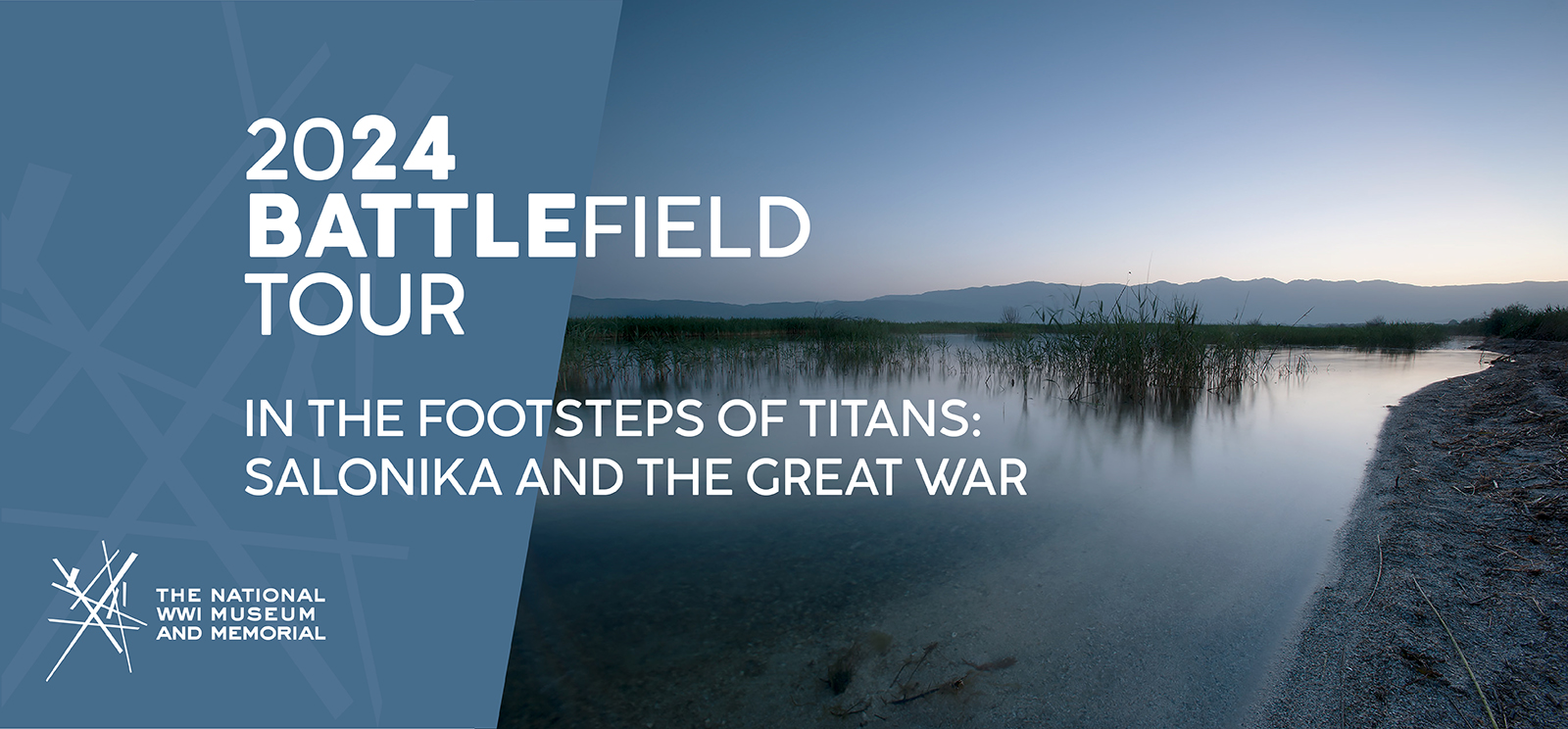
2024 Battlefield Tour
In the footsteps of titans: salonika and the great war, friday, sept. 13 – wednesday, sept. 18, 2024.
Venture into the crossroads of mythology and modernity with the National WWI Museum and Memorial as we explore the cultural and historical significance of the Salonika Front. From the dense forests and mountain landscapes of beautiful Greece, we will trace the forgotten trench lines of some of the war’s most remote battlefields and discover the global stories of this lesser-known theater rich in geopolitical importance as the “cradle of democracy.” The tour begins and ends in Thessaloniki (SKG) with five nights of lodging in the scenic Grecian countryside.
Please note:
This tour traverses rugged terrain and includes locations with steep and unpaved grounds. Unlike previous battlefield tours, much of this battlefield is inaccessible by vehicle. Participants MUST be able to walk a minimum of 6 miles without assistance and be able to carry their own equipment needed for hiking.
Planned Itinerary
Tour pricing, frequently asked questions.
Previous Tours
(May be subject to change)
Day 1: sept. 13.
Starting in Thessaloniki, the group’s first introduction to the campaign will be the Salonika (Lembet Road) Military Cemetery, containing personnel from all nations. The group will travel north to study Birdcage Line, constructed by the British Army in 1916, and end the day at the Doiran Memorial.
Overnight Doiran – Dinner included
Day 2: Sept. 14
Northbound from Doiran, the group will explore the furthest extent of the French Army’s advance in 1915, passing through Gradsko and Krivolak. Stopping at the Demir Kapija tunnel on the way back to Doiran, the group will study the Dec. 1915 retreat before finishing the day at Lake Doiran.
Overnight Doiran – Breakfast, Lunch and Dinner included
Day 3: Sept. 15
Most of the day’s travels will be on flat ground and near the group’s hotel in Doiran, examining key points of action in the Battles of Doiran like La Tortue, Hill 340, the Hilt and the Petit Couronné.
Day 4: Sept. 16
A full day’s hike to Devil’s Eye and its views over Pip Ridge, the scene of the final decisive battle of Salonika in Sept. 1918. En route to the site, the group will pass through the Bulgarian reserve positions, artillery and command bunkers, as well as the T Line bunkers and an isolated British Divisional Memorial.
Day 5: Sept. 17
Trekking through the Struma Valley, the group will explore the various actions at Tumbitza Farm, specifically the 27th Division attacks, as well as the British battery positions at Triada (Dragos) and the Bulgarian positions at Palio Castro. For the final evening, the group will return to Thessaloniki.
Overnight Thessaloniki – Breakfast, Lunch and Dinner included
Day 6: Sept. 18
Transfer to Thessaloniki Airport for departures.
Questions? Frequently Asked Questions
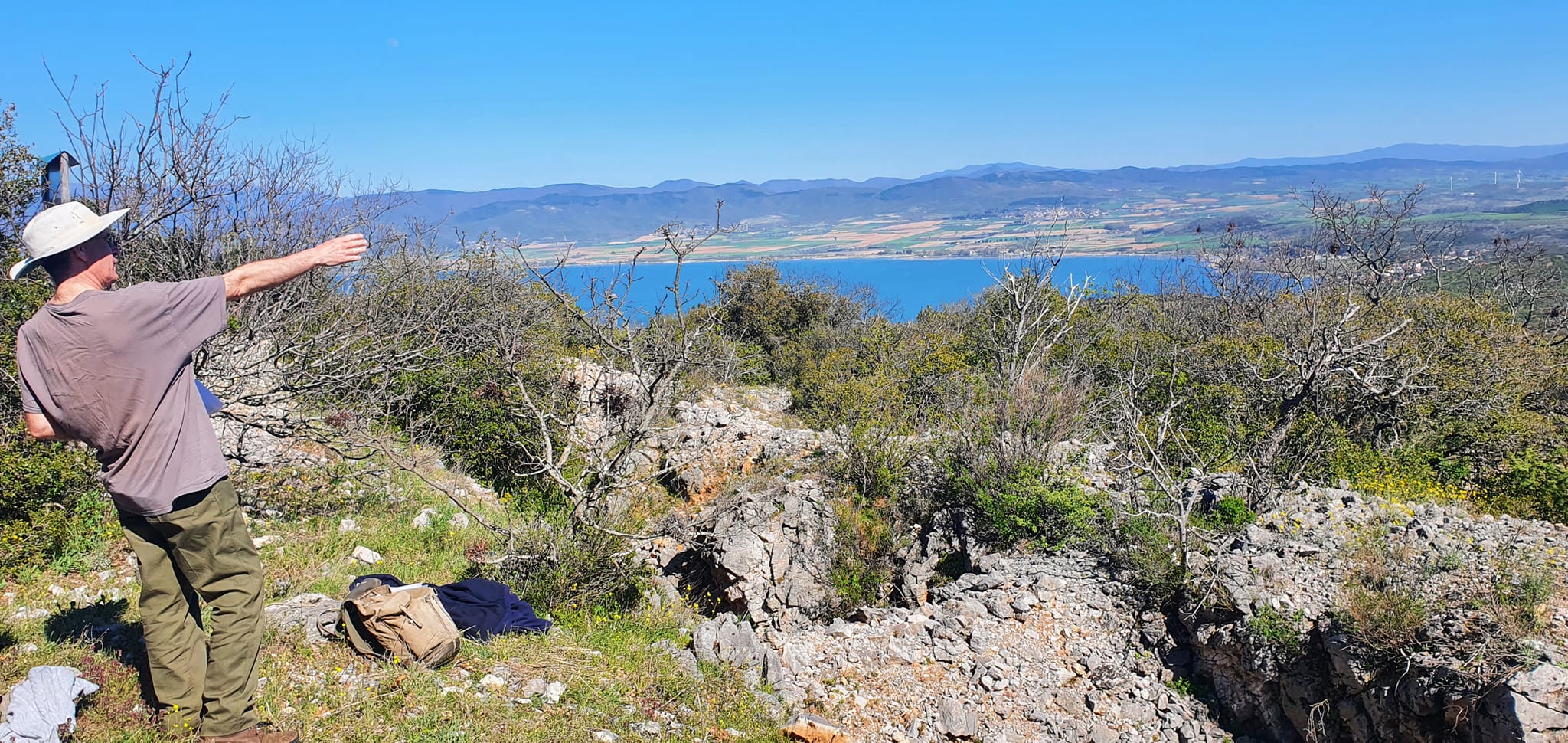

$500 deposit (per person) due by April 30, 2024
Account in full due by june 30, 2024, costs include:.
- Pick-up and drop-off at Thessaloniki Airport (SKG)
- Bus, driver and guides throughout tour
- 5 nights accommodation (includes all meals)
- Small group size
It does not include:
- Flights to and from Greece
- Incidentals
Travel Insurance
Traveler is responsible for securing their own optional travel insurance.
We encourage scheduling your arrival the day before the tour begins to avoid any risk of a delayed flight.
Ready to register? Registration
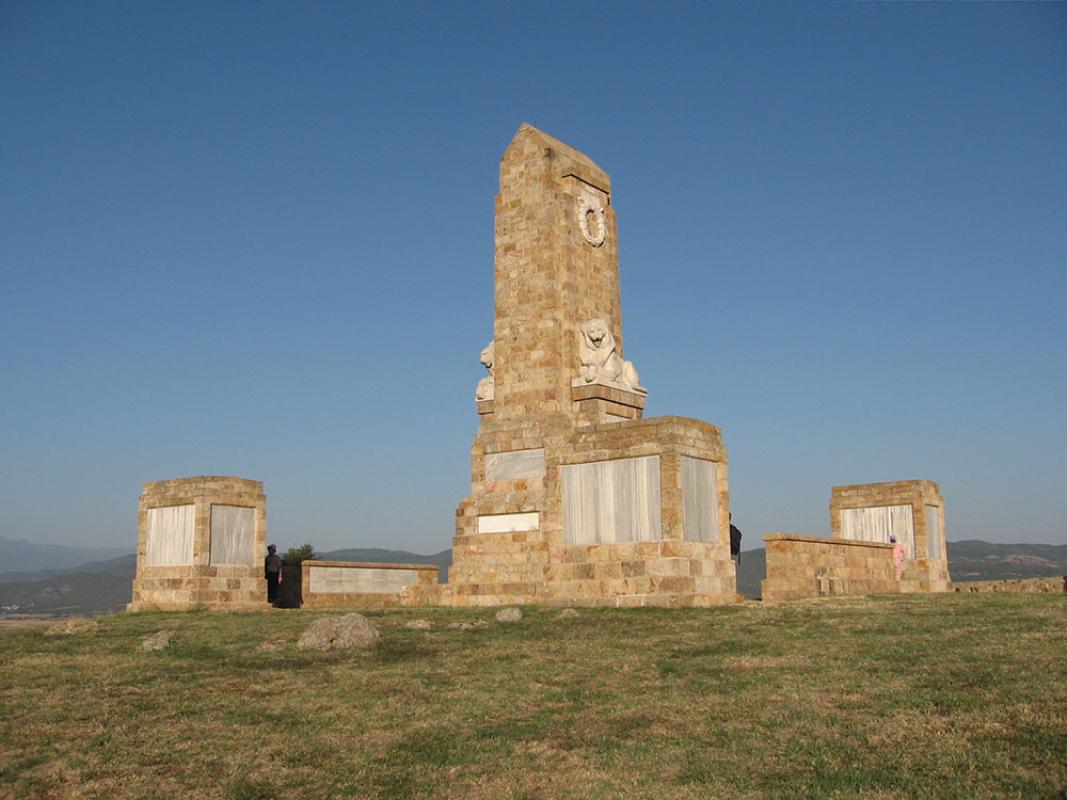
The British Memorial to the Missing near Lake Doiran.
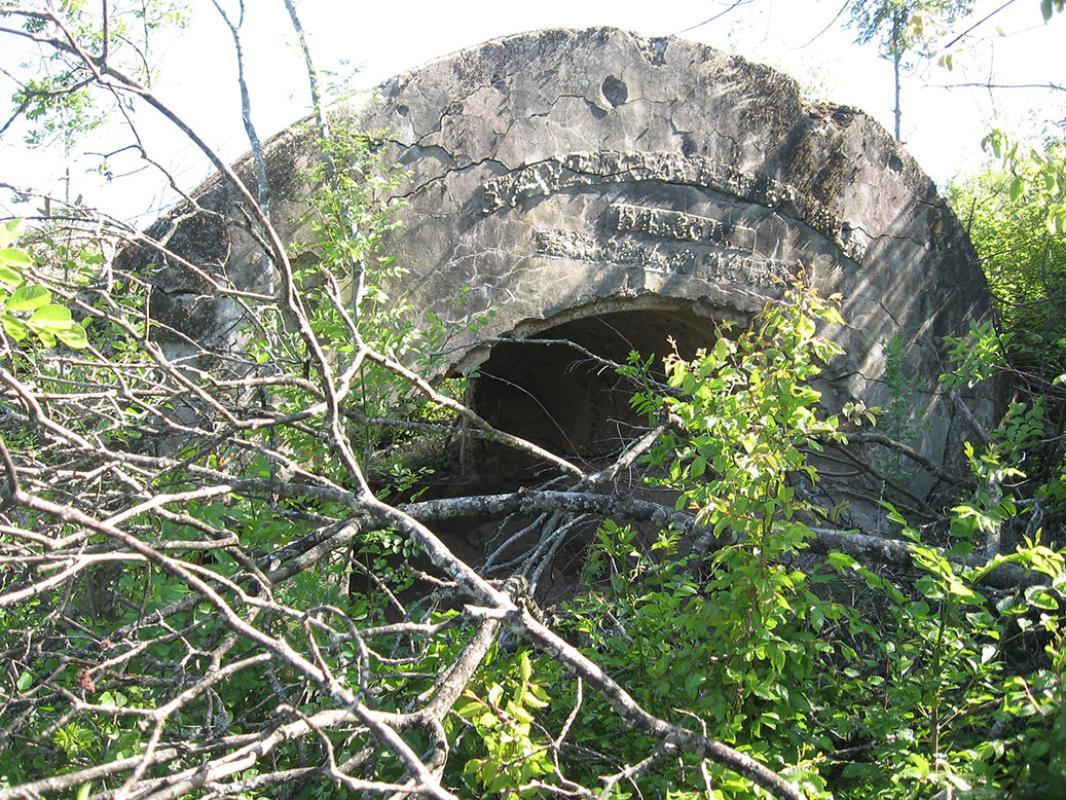
Bulgarian artillery position between Grand Couronné and Pip Ridge.
Please note: Modifications may occur due to current global travel restrictions.
When and where will we meet the group?
All participants should meet at the designated meeting place and time, provided with your tour information. It is recommended to arrive in the destination city the day before the tour, giving you ample time to meet at the gathering place. Once you receive the green light to purchase your airfare, please forward your arrival time and flight number to the Museum and Memorial's Learning Coordinator at [email protected] . This will assist guides in roll call before starting the tour.
What sites will we be visiting?
Please see the itinerary sent by the guides. The itinerary is loose, allowing flexibility in visiting additional sites.
What hotels will we be staying in? What amenities are included?
Please see the itinerary sent by the guides. Breakfast, WiFi and laundry services are generally available.
How many meals are included with my registration?
Breakfasts and at least one group dinner are covered under your registration. Lunches and other dinners are not included, unless otherwise specified. Please notify us immediately if you have any special dietary requirements. For most destinations, lunches will be approximately €15-€20 and dinners approximately €35.
How will we travel between different sites/cities?
Participants will travel by coach (bus) between cities and will walk around most sites.
What amenities are included with the bus?
The bus will have A/C and heating, a refrigerator, a restroom and complimentary water.
What should I wear?
- Comfortable outdoor wear (e.g. T-shirts, jeans, shorts.) Avoid wearing clothing with large, loud logos.
- Sweater or lightweight fleece
- Appropriate footwear (e.g. walking shoes). A change of footwear is also advised.
- Waterproof outer layers (light jacket)
- Hat and sunscreen
What are essential items I need to pack?
- Medicine (in your carry on!)*
- Camera or phone
- Night clothes
- Socks and underwear
- Satchel/day pack
- Electricity adapters for destination countries
- Portable power bank (if you have one)
- Waterproof jacket (and trousers if you have them)
- Sturdy shoes
- Large plastic bag for worn clothes
* Note on medicine: should be kept in its original packing, and kept in your carry-on along with a copy of any doctor's prescription. Please consult with State Department travel information to ensure that your prescriptions are not prohibited in the destination countries. Most over-the-counter medicines can be obtained abroad, though they may have different names than those in the U.S. One of the guides, where possible, will accompany you to a pharmacy (widely available) to assist with replacements, if needed.
I am staying in Europe after the tour. Can I be dropped off at my hotel after the tour?
Unfortunately, due to the size and schedule of the coach, you will not be able to be dropped off at your hotel by bus. If you need assistance returning to your hotel:
- See if your hotel has a shuttle service—communicate when and where you’ll need to be picked up.
- If a shuttle is unavailable, the guides can assist you in finding a taxi.
- If you’d prefer to use public transportation, the guides can assist you in getting the correct ticket/line.
How safe will I be touring in the Battlefield Tour regions?
Battle Honours hosts nearly 60 tours yearly and has been in the battlefield touring business for 15 years—many of the guides are former military or police. They have thoroughly assessed any potential risks that may occur during the tour—you will not be visiting any areas that may compromise your safety. Security is both their specialty and priority—you will be in very capable hands. To secure your money and passport, we recommend investing in a wearable money belt/pouch.
How much spending money should I bring with me?
We recommend bringing at least €200 in local currency, but how much you bring is truly a personal preference. Please make sure to notify your banks that you will be out of the country if you plan on taking your debit/credit/bank cards.
- VISA is most readily accepted; American Express/Discover are not accepted at most places.
- Cards issued by a smaller, regional bank that don’t have backing from larger institutions will not likely be accepted.
- ATMs are accessible everywhere for cash withdrawal—withdrawal fees/exchange rates may apply.
How can I use my cellphone while abroad?
You will need to contact your service provider to arrange an international plan (plans vary by provider.) To avoid roaming charges, we recommend turning off apps needing WiFi data before departure. Set your phone to “Airplane Mode” before boarding your overseas flight.
I have an ancestor who fought in World War I in this particular region. Can I see the sites pertinent to their involvement?
Yes! The guides cater the tour itinerary to these requests. Send the name, rank, and any key military/occupational identification of your WWI ancestor to Clive Harris and Mike Sheil approximately two months before departure, to give ample time for research.
Can I bring my ancestor’s personal items (a diary, photographs or other memorabilia)?
Yes, please do! These really help bring your ancestor’s story come to life on the battlefield. Please let the guides know what items you’ll be bringing before packing them.
How much can I expect to walk during the tour?
Participants can expect to walk multiple miles each day across uneven, unpaved terrain. Please make sure you have comfortable, sturdy walking shoes. Battlefield maps will be provided by guides on-site and via email to the participants.
What is the climate of the region we’ll be visiting?
Generally, weather will be warm to mild, and potentially rainy. Feel free to pack a light jacket for the evening and a day pack that includes snacks as you travel off the beaten path.
Questions about mobility and accessibility, or any other questions? Contact [email protected] or 816.888.8153.
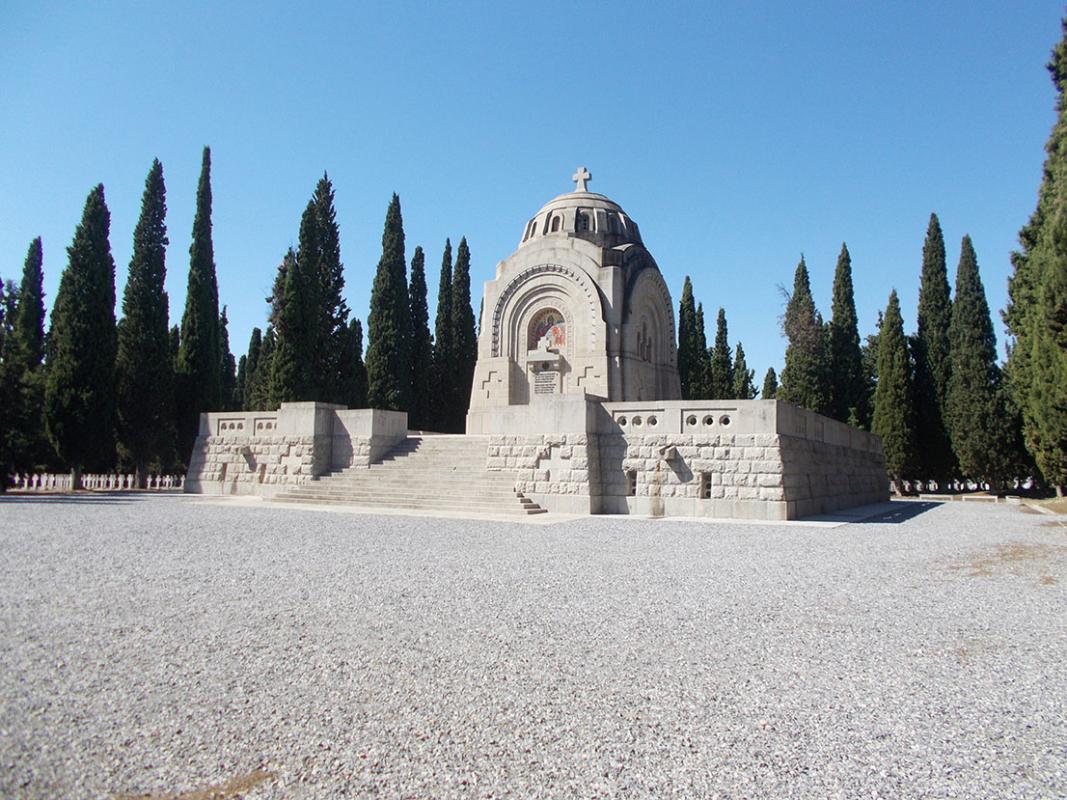
Serbian Mausoleum in Lembet Road Allied Military Cemetery.
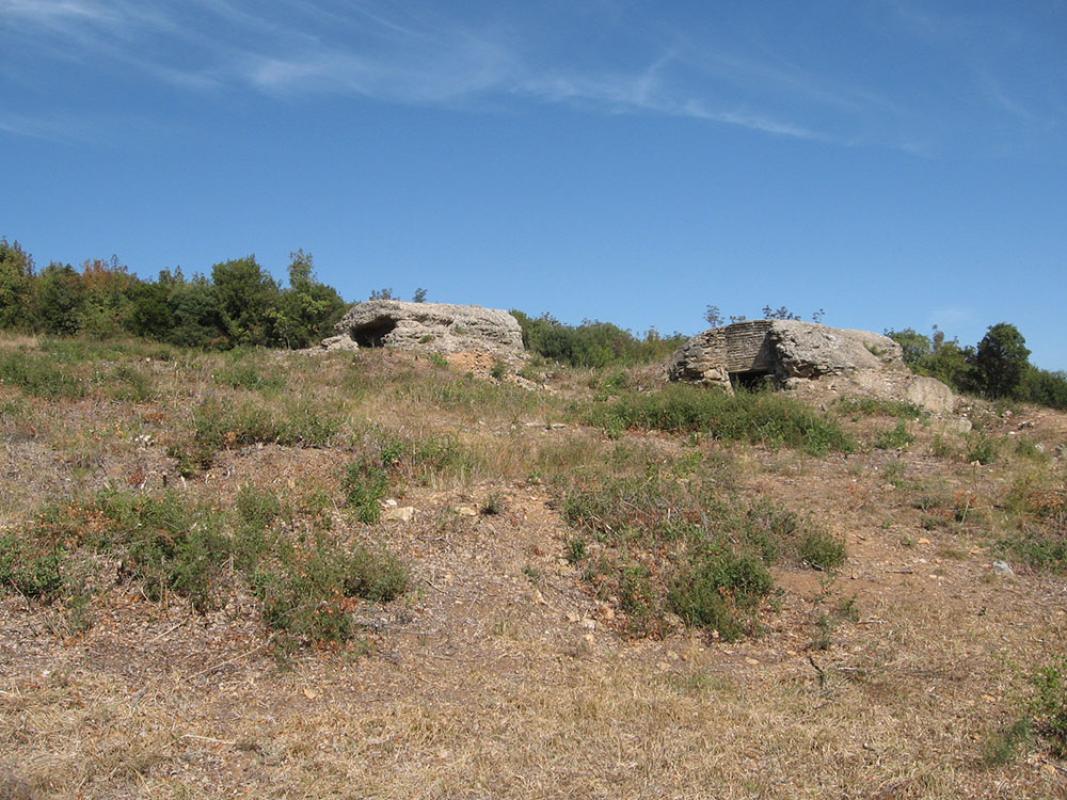
British artillery position on La Tortue.
Considering taking your first tour? View journals from our past tours:
2023: The War in Champagne (Instagram stories)
2022: Verdun and Saint-Mihiel (YouTube playlist)
2019: Gallipoli
2018: Harry S. Truman and the A.E.F.
2018: A.E.F. Centennial Tour of France
2017: The Doughboys in France
2016: British, Italian and American sectors of the Italian battlefields
2015: Imperial German Army on the Western Front
About Clive Harris
Raised in Hertfordshire, Clive developed a lifelong fascination with history. He spent seven years with the Royal Corps of Signals, serving operationally overseas with the 1st Armoured Division in BAOR — an Infantry attachment with the Royal Green Jackets, in Cyprus, Germany and France — and finally taking an instructor’s post in the Signals Wing of the Royal Military Academy Sandhurst. On leaving the army he joined his local Constabulary, serving 11 years in their Force Operations Room as a specialist communications officer and control room manager. In 1998, he began working as a speaker, writer, researcher and battlefield guide and since then has guided groups to the Somme, Ypres, Arras, Mons, Cambrai, The Hindenburg Line, Verdun, and Gallipoli for the Great War, as well as Normandy, Arnhem, The Italian Campaign, and of course the London Blitz for the Second World War. Clive is a Badged Member of the Guild of Battlefield Guides (No33) and also a member of the British Commission for Military History.
About Mike St Maur Sheil
Mike is the award-winning curator of Fields of Battle, Lands of Peace 1914-1918. After studying Geography at Oxford, in the early 1970s Mike began his career as a photojournalist covering “the Troubles” in Northern Ireland. Here he became associated with the New York picture agency, Black Star, and over thirty years later he is still in the fortunate position of being paid to do what he loves doing — taking photographs. Mike has visited over 60 countries around the world, working for a wide range of clients such as ABC-TV, BBC, Anti-Slavery International, British Red Cross, European Commission, National Geographic , The New York Times , Shell, Time and Time Life .
Images courtesy of Mike St Maur Sheil / Fields of Battle 1418
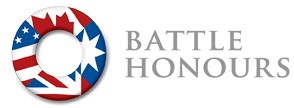

- Flemish masters
- Cycling along rivers
- Battlefields
- Tours from one Hotel
- Challenging tours
- Linear cycle route
- Why Belgium?
- Information
- Rental bikes
- Travel terms and conditions
- Cycling by Numbers
- Company history
Search results:
Belgium has an extensive military history that goes back centuries. As early as 1600, Prince Maurits defeated the Spanish army at Nieuwpoort, Napoleon found his Waterloo in the Flemish fields and more recently many victims were killed in the West Flemish battlefields (WWI) and during the Battle of the Bulge (WWII). We have developed beautiful journeys along these impressive landmarks in history. In addition to the impressive monuments from this history, you will also cycle through beautiful surroundings and past beautiful historic cities.
Beer and History in the Westhoek
- Beautiful cycling holiday through the rolling Westhoek
- Historical and vibrant cities like Lille and Ieper
- Visit de Lakenhalle and 'the Last Post' in the Menenpoort in Ieper
- Stay overnight (and taste) in a brewery
- Visit the Hopmuseum in Poperinge
- A journey along the historical battelfields from WWI
Easy cycling trip on relatively flat terrain, some stages will have a more winding character but still suitable for people with little or no cycling experience. Daily cycling distances span roughly 30-70 km.
West Flanders - Bruges, the Coast and 'Flanders Fields'
- Many WW1-related places of interest
- Ypres, Courtrai, Veurne, lovely historic villages
- Bruges town centre, a UNESCO World Heritage Site
- Winding inland routes
- Refreshing rides on the coast
Five Country Meuse - Vennbahn Combination Bicycle Holiday
- Cycling through 5 different countries within 10 days
- Cycling along the most beautiful part of the Meuse River
- Vennbahn, the most beautiful fromer railway turned into a cycle path
- Historic cities Maastricht, Liège and Aachen
- Relicts from WW II around Bastogne
You will cycle through a hilly area, you will encounter regularly inclinesr and sometimes a tough climb where you get off. It is also possible that the daily distances are sometimes a bit longer. Some cycling experience uphill is desirable, even when cycling with an e-bike. The daily distance span from 30 to 75 km.
The terrain is slightly hilly. You will encounter a short incline from time to time or maybe one or two heavy stages. With an e-bike and some cycling experience you should easily be able to handle this level. Daily distances span 50-75 km.
Amsterdam - Paris
- From the canals of Amsterdam to the Eifeltower of Paris
- Famous and beautiful towns like Gouda, Antwerp and Ghent
- Very varied landscapes
- Wonderful nature meets fascinating towns
You will cycle through a hilly area, you will regularly encounter inclines and there will be some tough stages in this tour. Requires a good condition, cycling experience in hills and a bicycle with mountain gears. A good battery with a long range is required for these journeys. The daily distance is between 30 and 80 km
Popular tours
- Amsterdam to Bruges
- The Flemish Beers Route
- The Pearls of North Flanders
- Brussels - Bruges
- Four Countries Vennbahn Trail
- Maastricht - Sedan
- Haspengouw - cycling through the fruitregion
- Who are we?
- General Information
- Environmental Policy
- Cookie settings
Celsiusweg 12
6662 PX Elst
Netherlands
+31(0)481 745 011

Belgian Bike Tours uses cookies to manage the website, to show you personalized content and to manage business goals. Below you can find more information on how we use cookies. You can accept all cookies, select them individually or reject them all. To learn more about our cookie policy, you can visit the dedicated page at any time.
Functional cookies
Always active. These cookies are necessary for the essential functional of the site, such as the management of network security and its accessibility. Standard cookies cannot be deactivated.
Analysis cookies
These cookies collect information, such as the number of users who are using our site or the most visited pages, to help us improve the user experience. Disabling these cookies makes it impossible for us to collect information to improve the browsing experience.
Advertising cookies
These cookies are set by us and/or our partners and help us build a profile of your interest based on your browsing profile. If you accept these cookies, you will be shown ads that match interests as you browse other sites.

- Regions
- Russia
- Moscow Oblast
Elektrostal
Cycling routes in
Find the right bike route for you through Elektrostal, where we've got 330 cycle routes to explore. The routes you most commonly find here are of the hilly type. Most people get on their bikes to ride here in the months of June and August.
Find cycle routes in Elektrostal:
Flat routes | Hilly routes | Uphill routes | Downhill routes | Quick rides | Long tours | Top rated routes
Join the fast growing global cycling community
Are you ready for the full cycling experience.

- Moscow Tours
- Customized tours
- Moscow for kids
- Evening activities
- Moscow evening activities
- St Petersburg evening activities
- Day trips out of Moscow
- Golden Ring tours
- St Petersburg tours
- Russian tour destinations
- Package tours
- Moscow highlights
- Travel Tips
- Upcoming group tours
- Moscow events
Moscow metro of the last 20 years

Request form

We use cookies to improve your experience on our website, and to facilitate providing you with services available through our website. By continuing to use our website, you accept our use of cookies, the terms of our Privacy Policy and Terms of Service . I agree
WW1 Battlefield Tour Companies and Guides
There are many individual guides and organizations offering a wide range of tours to the WW1 battlefields. Tours are available to suit all budgets, as all-inclusive packages or as tours and specialist guides for visitors once arrived in the battlefield areas. Tours may vary in length from half day visits to several days. Transport can range from using your own vehicle, bicycle or motorbike, to a minibus or full sized coach. Accommodation may be included as a package or can be arranged by you independently.
Most tours will cover the main sites of interest offering first-time travellers an introduction to the subject, and some tours will offer specialist detail on particular themes with accompanying expert military historians. You may have the opportunity to “walk the ground” on a study tour. In many cases a bespoke tour will be available to offer a personalized visit to the war grave of a relative or a specific place of action for family historians. Do remember to give your guide plenty of notice if you wish to do this!
Whichever way you choose to visit the battlefields, it is sure to be a fascinating and a thought-provoking experience. Many of the experienced guides now taking people to visit the 1914-1918 battlefields began their own interest in the subject with a visit to see where a relative was in action.
Tour Companies and Guides
- Guild of Battlefield Guides
- Listings of Tour Companies & Guides
Greatwar.co.uk aims to give an overview of organizations offering tours to the First World War battlefields. Some are all inclusive tours from your point of pick-up, others are based in Belgium or France in the WW1 battlefield regions. There are self-drive tour itineraries, cycling and motorbike tours, rail tours and tours for students to the Western Front battlefields.
Tour programmes will vary from general introductory tours to specialized tours focusing on specific battle actions or themes. We offer lists of companies or individual guides to assist travellers in finding a tour company or guide to suit your specific requirements. You are advised to contact the tour guide or company directly with any enquiry about the tours they offer and ensure that they comply with travel, package holidays and package tours regulations. Greatwar.co.uk cannot be held responsible for a guide or tour company failing to comply with package holiday travel regulations and public liability cover.
Guild of Battlefield Guides (GBG)
greatwar.co.uk is proud to be a Supporter of the International Guild of Battlefield Guides. The aim of the Guild is to raise the understanding and promote best practice for guiding on the battlefields.
The late Lt. Col. Graham Parker, OBE, Retd. and his daughter Joanna Legg organized battlefield tours as Flanders Tours for military, private and public groups from 1980 and 2000. They founded and operated tours as Flanders Tours for 12 of those years. Graham was honoured to have been made an Honorary Member of the International Guild of Battlefield Guides. Joanna is proud to promote the International Guild of Battlefield Guides and its Badged Guides. Members and Supporters are highlighted in our list of guides and tour companies.
Listings of Tour Companies and Guides
Battlefield Tour Companies and Guides (from the United Kingdom)
Battlefield Tour Companies and Guides based in Belgium and France
Cycling Routes & Tours on the WW1 Battlefields
Walking the WW1 Battlefields
Self-drive Itineraries & Tours of the WW1 Battlefields
Motorcycling Tours on the WW1 Battlefields
Battlefield Tours by Rail
WW1 Battlefield Tour Companies for Students & School Groups
Related Topics
Visiting the ww1 western front battlefields.
Advice and useful information about travelling, accommodation and tourist information for visitors to the Western Front battlefields:
Visiting WW1 Western Front Battlefields
Battlefields of the Western Front
Pages on the battlefields by area including comprehensive listings and locations of military cemeteries, main memorials, battle remains, museums and accommodation:
French Flanders and Artois
The Somme, Picardie, France
International Guild of Battlefield Guides
The International Guild of Battlefield Guides is for guides with a specialism in battlefield history, providing an organization where guides can meet one another, share information and approaches to the subject. Members of the Guild can take part in an accreditation programme to become a “Badged Guide”. For more information see the website:
Website: www.gbg-international.com
Somme Battlefields' Partner, France
The Somme Battlefields' Partner is a new network for visitors to the Somme, where local professionals involved in tourism and the history of this battlefield area have come together. The Somme Battlefields' Partner website is at:
Website: www.somme-battlefields.com
- Western Front Battlefields
- Battlefield Visits
- Memorials & Monuments
- Museums & Archive Collections
- Tracing Family History
- Researching Military History
- Education Resources
- Experience of the Great War
- Remembrance
- Organizations
- The Poppy Umbrella
- Tours from UK
- Tours start in Belgium/France
- Cycling Tours
- Walking Tours
- Self-Drive Tours
- Motorcycle Tours
- Tours by Rail
- Tours for Schools & Students
- Travel Maps
- Accommodation
Copyright © www.greatwar.co.uk All rights reserved.

Tvel completes development of new fuel for Paks nuclear plant
!{Model.Description}

The full package of documents is handed over to the Hungarian customer, MVM Paks Ltd, for further licensing of the new fuel by the national nuclear power regulator, Tvel said.
The first fuel assemblies have also passed acceptance testing at Tvel's Elemash Machine-building plant in Elektrostal, Moscow region.
The new modification of VVER-440 second generation fuel increases the efficiency of fuel usage and advances the economic performance of the power plant operation, Tvel said.
The engineering contract for development of the new VVER-440 fuel was signed in late 2017. The development and validation work involved a number of Russian enterprises, including OKB Gidropress (a part of Rosatom machine-building division Atomenergomash), Bochvar Institute (material science research facility of TVEL Fuel Company), Elemash Machine-building plant and Kurchatov Institute national research center. At the site of OKB Gidropress research and experiment facility, the new fuel passed a range of hydraulic, longevity and vibration tests .
The first consignment of the modified fuel will be delivered to Paks nuclear power plant later this year. The four-unit Paks nuclear plant, which entered operation between 1982 and 1987 currently operate on a 15-month fuel cycle and supply around 50% of Hungary's electricity.
Photo: Fabrication of new VVER-440 fuel for Paks nuclear plant (Credit: Tvel)
- Terms and conditions
- Privacy Policy
- Newsletter sign up
- Digital Edition
- Editorial Standards

- History of cooperation
- Areas of cooperation
- Procurement policy
- Useful links
- Becoming a supplier
- Procurement
- Rosatom newsletter
© 2008–2024Valtiollinen Rosatom-ydinvoimakonserni

- Rosatom Global presence
- Rosatom in region
- For suppliers
- Preventing corruption
- Press centre
Rosatom Starts Life Tests of Third-Generation VVER-440 Nuclear Fuel
- 16 June, 2020 / 13:00
This site uses cookies. By continuing your navigation, you accept the use of cookies. For more information, or to manage or to change the cookies parameters on your computer, read our Cookies Policy. Learn more

IMAGES
VIDEO
COMMENTS
Jeremy has led numerous cycling tours over the past few years and has experience in groups of all sizes. Recent testimonial: "We spent three fantastic days with Jeremy exploring the battlefields of the Somme, Arras and Loos - on bikes! ... Mountain bikes will make easy work of the tracks but will be slower on tarmac. As a guide, when ...
Telephone: +32 477 592 382. Email: [email protected]. Website: www.bikingbox.be. Guided tours visiting the Great War Western Front battlefields by bike for a half day, a full day or over several days. Probably the best way to witness the landscape and try to understand what happened one century ago.
A fully guided cycle tour of the key sites associated with the British section of the Western Front. Cycling, at your pace, along quite country lanes and in many cases along dedicated and well maintained cycle paths. Time to explore the beautifully restored town of Ypres, Lens, Arras, Albert and Amiens. Attendance at the Menin Gate ceremony.
A great introduction to battlefield touring in France by bike is the Battle of the Somme. Fought in 1916 during the First World War, it covers an area of about 200 square miles with the front line being about 30 miles long. Lord Haig, the Commander in Chief of the British and Commonwealth Army, launched his attack on the first of July with ...
The 250-acre preserved battlefield park in which it's found is a tribute to the 60,661 Canadian Expeditionary Force members who died in World War One. Paris-Roubaix. Away from war, head east ...
Tour de France riders will pass though the Menin Gate at Ypres, a stone arch memorializing the thousands killed in battles around this pretty Belgian market town between 1914 and 1918. Courtesy of ...
Battlefields by 4x4. Telephone: 0701 424 1418 (calls charged at premium rate) Email: [email protected]. Website: www.battlefieldsby4x4.com. Battlefield tours led by experienced battlefield guides and qualified off-road drivers, which are specifically designed for owners of standard four wheel drive vehicles.
Tour of Burgundy. Via Allier. Via Fluvia Avenue Verte UK. Bay Cycle Way. Border Raid. C2C. Celtic Trail. Coast & Castles. Cornish Way. Cotswold Line. Cycle across the Beacons. Devon C2C. East Midlands Cycleway. Easy East Coaster. Hadrian's Cycleway. Heads of the Valleys. Hebridean Way. Kennet & Avon. Lon Cambria. ... WW1 Battlefields ...
Visit a WW1 Grave or Memorial. Visiting a grave at Guillemont Military Cemetery on the 1916 Somme battlefield. An interest for many people wanting to visit the battlefields is the discovery of a relative who fought on the Western Front. In many cases tracing the war service of a relative leads to the knowledge that that the person was killed in ...
My name is John Phelan and my passion is the First World War Western Front in France and Belgium. My other passion is cycling and I've combined these two passions into Battlefield Cycling. My first trip to the Western Front was in 2000. Then in 2001 while studying in Tours, France, I rode from Tours to the Normandy Invasion Beaches, exploring the Battle for Normandy along the way.
Fully Supported and Self Guided bike tours are available. ... Cycle or Walk the evocative WW1 and WW2 battlefields in the company of a knowledgeable guide. Cycling Tours (self guided) From £695. Ride under your own steam along our painstakingly researched routes. Optional luggage transfers available.
Friday, Sept. 13 - Wednesday, Sept. 18, 2024. Venture into the crossroads of mythology and modernity with the National WWI Museum and Memorial as we explore the cultural and historical significance of the Salonika Front. From the dense forests and mountain landscapes of beautiful Greece, we will trace the forgotten trench lines of some of the ...
Founded in 2005 and originally known as TrenchMap Tours, To The Front Line Battlefield Tours has provided exceptional personalised service to thousands of satisfied clients who have visited the former battlefields of the First World War. We welcome a broad range of clientele, from those looking for an introductory tour to those who return to ...
Thank you for visiting our website which we designed and built ourselves so it's completely free of all the tracking 'cookies', adverts and other nonsense.James Power2024. Somme Battlefield Tours Ltd Wimborne Dorset BH21 1EJ +44 (0) 7776 195773 or +44 (0) 1202 [email protected].
Cycle along the famous Flanders Fields • Explore the battle of the Bulge by bike • Book on Belgian Biketours.com Bicycle holidays in Belgium +31 (0)481 745 011 ... (WWI) and during the Battle of the Bulge (WWII). ... Belgian Bike Tours uses cookies to manage the website, to show you personalized content and to manage business goals. ...
Motorcycling Tours on the WW1 Battlefields. Cycling on the Battlefields. On the more frequently visited battlefields, such as the Ypres Salient and the Somme, there are maps available from the local Tourist Offices for cycling routes. Some organized battlefield tours also offer guided battlefield walks or cycling tours. Some of the hotels, Bed ...
Battlefield Tours by Bike. One of our specialities is battlefield tours. As the late Professor Richard Holmes said: 'You cannot really understand a battle without viewing the ground on which it was fought. Part of the process is intellectual to see how ridges provided fields of fire and woods offered cover. But, part of it, too, is emotional.
WW1 Battlefield Tours with Specialist Guides. Our exceptional range of World War 1 Battlefield Tours cover the key battlefield sites of the Great War across Belgium and France. Whether it's visiting Flanders Field, walking the battlegrounds of the Somme, or standing on the front line of the Ypres Salient, there's nothing more rewarding than ...
Find the right bike route for you through Elektrostal, where we've got 327 cycle routes to explore. ... Quick rides | Long tours | Top rated routes 6,846 km Mapped Ways. 327 Cycle Routes. 144,387 Population. Top user routes in Elektrostal Электросталь -Клязьма 25 km ...
Tour cost: 1000 RUB Meeting time: 10.30 AM Meeting place: TBA. Request form. Your name * Your family name * E-mail * Phone number * Number of travellers: Other special request * required field . Top Moscow and Russia tours. Moscow in 1 day. Customized tours. Moscow in 2-3 days. Day trips out of Moscow. Golden Ring tours.
The Somme Battlefields' Partner is a new network for visitors to the Somme, where local professionals involved in tourism and the history of this battlefield area have come together. The Somme Battlefields' Partner website is at: Website: www.somme-battlefields.com. Tour operators and guides offering WW1 battlefield tours to Belgium and France.
Russian fuel company TVEL has completed a project to develop and validate nuclear fuel modifications for the VVER-440 reactors in operation at the Paks nuclear power plant in Hungary. The full package of documents is handed over to the Hungarian customer, MVM Paks Ltd, for further licensing of the new fuel by the national nuclear power ...
The life tests started after successful completion of hydraulic tests (hydraulic filling) of the mock-up with the aim to determine RK3+ hydraulic resistance. Life tests are carried out on a full-scale research hot run-in test bench V-440 and will last for full 1500 hours. The aim of tests is to study mechanical stability of RK3+ components ...